Home » Original Articles • Urdu Articles » کیا وہابیوں اور وہابی شدہ دیوبندیوں کے طرف سے اولیا الله کے مزارات پر حملے جائز ہیں؟
کیا وہابیوں اور وہابی شدہ دیوبندیوں کے طرف سے اولیا الله کے مزارات پر حملے جائز ہیں؟
posted by Abdul Nishapuri | December 15, 2013 | In Original Articles, Urdu Articlesبد قسمتی سے گزشتہ چند عشروں میں پاکستان، افغانستان، ہندوستان اور دنیا کے دیگر ممالک میں اہلسنت مسلمانوں کے اندر سعودی وہابی نظریات پھیلتے جا رہے ہیں جس کی وجہ سعودی عرب کی جانب سے دنیا بھر میں ہزاروں کی تعداد میں وہابی مساجد اور مدرسوں کی تعمیر، وہابی کتابوں، ویب سائٹس اور ٹیلی ویژن چینلز کی بھرمار اور وہابی دانشوروں، مبلغین اور صحافیوں کا پراپیگنڈ ہ ہے
مثال کے طور پر پاکستان، عراق، لیبیا، مالی، سعودی عرب اور شام میں وہابی اور وہابی فکر سے متاثر شدہ تکفیری دیوبندی گروہ نے سینکڑوں مزاروں اور درگاہوں پر بم دھماکے اور خودکش حملے کیے ہیں جن میں نہ صرف صحابہ کرم، اہلبیت اور اولیا الله کے مزارات کی بے حرمتی ہوئی بلکہ ہزاروں بے گناہ سنی بریلوی، صوفی اور شیعہ مسلمان بھی وہابی و تکفیری دیوبندوں کے ہاتھوں شہید ہوۓ
اس پوسٹ میں ہم مخلتف دلائل اور تصاویر سے ثابت کریں گے کہ اولیا اللہ کے مزارات پر وہابی اور تکفیری دیوبندی گروہ کے حملے اسلاف کی سنت اور شریعت کے احکام کے مخالف ہیں
اہلسنت کے عقیدہ کے مطابق انبیا، اہلبیت، صحابہ اور اولیا کی قبور کی با قاعدہ نشاندھی اور پختہ تعمیر کی جا سکتی ہے اور ان کی قبروں کی زیارت اور ان کی برکت کے توسط سے الله کے فضل و کرم کی دعا کرنے میں کسی بھی قسم کی دینی ممانعت نہیں –
قبروں پر منظم حملوں کا آغاز سعودی وہابی مسلک کے بانی شیخ محمد ابن عبدالوہاب نے کیا – وہابی اور تکفیری دیوبندی جھوٹا الزام لگاتے ہیں کہ سنی اور شیعہ مسلمانوں کی اکثریت قبور مبارک پر جا کر سجدے کرتی ہے اور صاحب قبر کی عبادت کرتی ہے – یہ بات حقیقت کے خلاف ہے – سنی اور شیعہ مسلمانوں کی غالب تعداد قبروں کی زیارت فقط قرب الہی کی غرض سے کرتی ہے – اگر کسی ایک آدھ بے شعور شخص نے کسی قبر کو سجدہ کر لیا تو اس کا عمومی اطلاق تمام قبور اور ان کی زیارت کرنے والوں پر نہیں ہو سکتا – نہ ہی یہ امر قبور پر پر تشدد حملے کرنے کا جواز بن سکتا ہے
شرک اور بدعت کے جھوٹے الزامات کی بنیاد پر بناپر وھابیوں نے قبور کی زیارتوں اور غیر خداکو پکارنے کو ممنوع قرار دیا مثلاً کوئی کہے یا محمد اور یا رسول الله – اسی طرح غیر خدا کو خدا کی بارگاہ میں وسیلہ قرار دینا یا قبور کے پاس نمازیں پڑھنایا اس طرح کی دوسری چیزیں ، ان سب کو شرک قرار دیدیا، اس سلسلہ میں وہ سنی اور شیعہ کے درمیان کسی فرق کے قائل نہیں ہیں۔
محمد بن عبد الوھاب کا نظریہ یہ تھا کہ جو لوگ اہلبیت، صحابہ کرم، اولیا الله عبد القادر،عروف کَرخی ، زید بن الخطاب اور زُبیر کی قبروں سے متوسل هوتے ھیں وہ مشرک ھیں اسی طرح جواھل سنت شیخ عبد القادر کو شفیع قرار دیتے ھیں ان پر بھی بھت سے اعتراضات کئے ۔ وہابیوں اور تکفیری دیوبندیوں کے مطابق جو لوگ حضرات علی، عثمان،، حسین ، موسیٰ کاظم وغیرہ کے روضوں پر اور ا عبدالقادر ،حسنِ بصری اور زبیر وغیرہ کی قبروں پر زیارت کرتے هوئے اور قبور کے نزدیک نماز پڑھتے هوئے اور ان سے حاجت طلب کرتے هوئے دیکھے کہ یہ لوگ سب سے زیادہ گمراہ ھیں اور کفر وشرک کے سب سے بلند درجے پر ھیں۔
اس بات کا مطلب یہ ھے کہ چونکہ شیعہ اور سنی قبروں کی زیارت کے لئے جاتے ھیں اور وھاں پر نمازیں پڑھتے ھیں اور صاحب قبر کو وسیلہ قرار دیتے ھیں لہٰذا کافر ھیں، اسی عقیدہ کے تحت وھابی اور تکفیری دیوبندی اپنے علاوہ تمام سنی، شیعہ مسالک کو کافر یا مشرک قرار دیتے ہیں اور تمام ممالک کو دار الکفر (کافر کے ممالک) کہتے ھیں اور اس ملک کے رہنے والوں کو اسلام کی طرف دعوت دیتے ہیں۔
یہی وہ تکفیری فکر ہے جو اکابر اہلسنت ائمہ کے طرز عمل کے خلاف چلتے ہوۓ سنی صوفی بریلوی مسلمانوں کو مشرک اور شیعہ مسلمانوں کو کافر قرار دیتی ہے جبکہ یہ امر واضح ہے کہ امام ابو حنیفہ نے کبھی شیعہ مسلک کی تکفیر نہیں کی اور اسی طرح سنی صوفی مسلک اور مزار بنانے کو شرک قرار دینا بھی وہابیوں اور تکفیری دیوبندیوں کا من گھڑت عقیدہ اور بدعت ہے
اسی طرح وھابی علماء میں سے شیخ حَمَد بن عتیق نے اھل مکہ کے کافر هونے یا نہ هونہ کے بارے میں ایک رسالہ لکھا جس میں بعض استدلال کے بناپر ان کو کافر شمار کیا، یہ اس زمانہ کی بات ھے جب وھابیوں نے مکہ شھر کو فتح نھیں کیا تھا۔ جن شھروں یاعلاقوں کے لوگوں میں جو نجدی حاکموں کے سامنے تسلیم هوجاتے تھے ،ان سے
قبول توحید کے عنوان سے بیعت لی جاتی تھی۔
وہابیوں کے یہاں زیارت نام کا کوئی عمل نھیں ھے، چنانچہ اسی نظریہ کے تحت تمام قبریں مسمار کردی گئیں اور روضہ رسول کو اس کی حالت پر چھوڑ دیا گیا، اور اس وقت اس طرح ھے کہ کوئی بھی آپ کی قبر مطھر کے نزدیک نھیں هوسکتا ھے اور آپ کی قبر مطھر ھر گز دکھا ئی نھیں دیتی ۔روضہ منورہ کے چاروں طرف دیوار ھے اور ھر طرف ایک حصے میں جالی لگی هوئی ھے اور ان جالیوں کے پاس وھاں کے شرطے (محافظ) کھڑے رھتے ھیں او راگر کوئی آنحضرت صلی اللہ علیہ و آلہ وسلم کے روضہ کی جالی کے نزدیک هونا یا ھاتھ لگانا چاھتا ھے تو وہ روک دیتے ھیں، اور اگر کوئی شرطوں کی غفلت کی وجہ سے جالیوں کے اندر سے جھانک کر دیکھتا بھی ھے تو پھلے تو وھاں تاریکی نظر آتی ھے اور جب اس کی آنکھیں کام کرنا شروع کرتی ھیں تواندر دکھائی دیتا ھے کہ ایک ضخیم پردہ ھے جو قبر کے چاروں طرف زمین سے چھت تک موجود ھے لہٰذا قبر مطھر کو بالکل دیکھا نھیں جاسکتا۔
اس بات کی طرف اشارہ کرنا ضروری ھے کہ قبور کی زیارت، اسی طرح قبروں پر عمارت یا گنبد بنانا شروع ھی سے اسلامی فرقے اپنے بزرگوں کی قبروں پر بھترین عمارتیں بنایا کرتے تھے ان کے لئے بھت سی چیزیں وقف بھی کیا کرتے تھے اور ان کی زیارت کے لئے بھی جایا کرتے تھے اب بھی یہ سلسلہ جاری وساری ھے۔
بغداد میں ابوحنیفہ کی قبر پر ایک قدیمی بڑااور سفید گنبد اب بھی موجود ھے، جس کی ابن جُبیر نے توصیف بھی کی ھے اور آج بھی ابو حنیفہ کی قبر کا گنبد بھت خوبصورت ھے جس کی دور اور نزدیک سے ہزاروں لوگ زیارت کے لئے جاتے ھیں، اسی طرح احمد ابن حنبل کی قبر اوربغداد میں شیخ عبد القادر جیلانی کی قبر ، اسی طرح مصر کے قرافہ شھر میں امام شافعی کی قبرمذاھب اربعہ کے بزرگوں کی بھت سی قبریں مختلف اسلامی ملکوں میں زیارتگاھیں بنی هوئی ھیں۔
ابن خلکان کھتا ھے: ۴۵۹ھ میں شرف الملک ابو سعد خوارزمی ،ملک شاہ سلجوقی کے مستوفی (حساب دار) نے ابو حنیفہ کی قبر پر ایک گنبد بنوایا اور اس کے برابر میں حنفیوں کے لئے ایک مدرسہ بھی بنوایا ، ظاھراً ابو سعد نے مذکورہ عمارت ”آلُپ ارسلان سلجوقی“ کی طرف سے بنوائی ھے
اسی طرح ”ابن عبد البِرّ“ (متوفی ۴۶۳ھ)کی تحریر کے مطابق ، جناب ابو ایوب انصاری کی قبر قسطنطیہ (اسلامبول) کی دیوار کے باھر ظا ھرھے اور لوگوں کی تعظیم کا مر کزھے اور جب بارش نھیں هوتی تو وھاں کے مسلمان ان سے متوسل هوتے ھیں۔
ابن الجوزی ۳۸۹ھ کے واقعات کو قلمبند کرتے هوئے کھتا ھے کہ اھل سنت مُصعب بن الزبیر کی قبر کی زیارت کے لئے جاتے ھیں جس طرح شیعہ حضرات امام حسین کی قبر کی زیارت کے لئے جاتے ھیں۔
ابن جُبیر، چھٹی صدی کا مشهور ومعروف سیاح اس طرح کھتا ھے کہ مالکی فرقہ کے امام، امام مالک کی قبر قبرستان بقیع میں ھے ، جس کی مختصر سی عمارت اور چھوٹا ساگنبد ھے اور اس کے سامنے جناب ابراھیم فرزند رسول خدا صلی اللہ علیہ و آلہ وسلم کی قبر ھے جس پر سفید رنگ کا گنبد ھے۔
مذاھب اربعہ کے بزرگوں کی قبروں پر گنبدهونا ، ان پر عمارتیں بنانا،ان کے لئے نذر کرنا ، وھاں پر اعتکاف کرنا ،ان سے توسل کرنا ،صاحب قبر کی تعظیم وتکریم کرنا او روھاں دعا کے قبول هونے کا اعتقاد رکھنا بھت سی تاریخی کتابوں میں موجود ھے اور اس وقت بھی قاھرہ، دمشق اور بغداد اور دوسرے اسلامی علاقوں میں ان کے بھت سے نمونے اور قبروں پر مراسم هوتے ھیں جنھیں آج بھی دیکھا جاسکتا ھے۔
دور حاضر کے معروف اہلسنت عالم دین مولوی علی احمد سلامی المعروف مولوی نذیر احمد کے مطابق اولیا الله کے مزاروں پر حملہ کر نے والے وہابی اور دیوبندی مسلمانوں کے نصی، ظاہری اور جذباتی گروہ سے تعلق رکھتے ہیں
===================
نصی، ظاہری، جذباتی گروہ: یہ وہ لوگ ہیں جو قرآن کی ایک عبارت یا اسی نص قرآن کو اپنے اعمال کی بنیاد قرار دیتے ہیں اور جذباتی انداز میں عمل کرتے ہیں۔ یعنی وہ قرآنی نصوص اور عبارات کو رسول خدا(ص)، ائمہ اور اصحاب کے عمل کی کسوٹی پر نہیں پرکھتے کہ اس طرح اس سے ایک مشترکہ صورت نکال سکیں۔ یہ لوگ اکثرا جاہل، ناخواندہ اور کم بصیرت ہیں، حتی کہ وہ اپنے منہج و روش کے بھی پابند نہیں ہیں۔ اس طبقے کے افراد علمی لحاظ سے بہت نیچے اور جاہل ہیں۔ جو لوگ دوسروں کی تکفیر کرتے ہیں ان کا تعلق اسی گروپ سے ہے۔ اس گروہ کے بعض افراد سلفی بھی ہیں۔ اس گروہ کے سلفی اپنے آپ کو وہابی نہيں سمجھتے بلکہ سلفی سمجھتے ہیں؛ لیکن ہم انہيں وہابی کہتے ہیں۔ وہ قرآن و سنت کی ظاہری صورت کی طرف توجہ دیتے ہیں اور دوسروں کو مسلمان نہيں سمجھتے۔ ان لوگوں کی روش ان ہی وہابیوں کی مانند ہے جو دوسری صدی ہجری میں گذرے ہیں (جو خارجی تھے)۔
یہ جو مقدس مقامات کو تباہ کرتے ہیں اگر سلفی ہوں تو میں نے عرض کیا کہ یہ نصی، ظاہری اور جذباتی گروہ سے تعلق رکھتے ہیں اور ان کا عقیدہ ہے کہ قبر کو گنبد و بارگاہ بنانا اور اینٹ اور سیمنٹ سے کام لینا نادرست ہے۔ وہ کہتے ہیں کہ “ہمارے پاس روایت ہے کہ قبر کے اوپر عمارت اور گنبد تعمیر نہیں کرنا چاہئے۔ لیکن مسلمانوں میں سے ایسے افراد بھی ہیں جو قبور کے اوپر عمارت اور گنبد بنانے کے قائل ہیں۔ پس حکومت شام کے مخالفین کو دوسروں کے اعتقادات کا احترام کرنا چاہئے۔ وہابی مخالفین اگر اس امر کے معتقد نہیں ہیں تو وہ خود قبور پر عمارت اور گنبد و بارگاہ نہ بنائیں۔ دوسروں کے اعتقادات پر حملہ نہيں کرنا چاہئے۔ ان مقابر کا انہدام جرم ہے اور باعث گناہ ہے۔ مراقد کا انہدام ـ نہ صرف اس لحاظ سے کہ رسول اللہ(ص) کے فرزندوں کا مدفن ہیں ـ جائز نہیں ہیں بلکہ مقدسات اور بزرگوں کے مراقد کی تخریب شرعی لحاظ سے بھی جائز نہيں ہے کیونکہ جن لوگوں نے یہ مراقد بنائے ہیں وہ اس پر عقیدہ رکھتے ہیں اور لوگوں کے معتقدات کو محفوظ رہنا چاہئے۔
قرآن مجید نے تو یہ تک فرمایا ہے کہ “َلاَ تَسُبُّواْ الَّذِينَ يَدْعُونَ مِن دُونِ اللّهِ”، تم ان لوگوں کی بےحرمتی بھی مت کرو جو غیر خدا کی پرستش کرتے ہیں ۔۔۔؛ خلاصہ یہ کہ شرعی لحاظ سے مقامات مقدسہ، مساجد، امام بارگاہوں افراد کے مقابر وغیر کی توہین و تخریب کا حق نہيں پہنچتا۔ وہابی گروہ نے صرف بقیع کو منہدم نہيں کیا بلکہ جہاں بھی گنبد و بارگاہ کو دیکھا، سوائے بارگاہ نبوی کے، سب کو منہدم کیا۔ ان کی دستاویز ایک روایت ہے کہ “لا بناء علی القبر” (قبر پر عمارت نہیں بنانا چاہئے)، ان کا عقیدہ یہ ہے کہ گنبد و بارگاہ کا انہدام صاحب قبر کی توہین نہیں ہے- عثمانیوں کے زمانے میں شہدائے بدر کے لئے اور مدینہ کے لئے گنبد و بارگاہ بنانے کا اہتمام کیا گیا۔ لیکن جب یہ وہابی برسر اقتدار آئے تو انھوں نے تمام تعمیرات کو ویران کردیا۔ وہابیوں کے اس اقدام پر علمائے اسلام کی ایک بڑی تعداد اور خاص طور پر عثمانی معترض ہوئے جنہوں نے ان گنبدوں کی تعمیر کا اہتمام کیا تھا اور دنیائے اسلام میں تنازعہ کھڑا ہوگیا لیکن انھوں نے کوئی توجہ نہ دی اور چونکہ اقتدار ان کے ہاتھ میں تھا اس لئے گنبد و بارگاہ کو منہدم کیا۔ ہم ان اقدامات کو جائز نہيں سمجھتے۔ آثار کو باقی رہنا چاہئے۔ وہ آثار جو ظاہر کرتے ہيں کہ قبر فلان شخص کی ہے، انہيں رہنا چاہئے۔ قبور ان کتبوں اور آثار سےپہچانی جاتی ہیں جو باقی رہتی ہیں۔ یہ اعمال درست نہیں ہیں۔
=================
یہ بات قابل غور ہے کہ سنی مسلک کے چار عظیم المرتبت ائمہ امام ابو حنیفہ، امام مالک، امام شافعی اور امام احمد ابن حنبل کے مزارات آج بھی موجود ہیں جن پر لاکھوں لوگ عقیدت اور برکت کی غرض سے حاضری دیتے ہیں
بر صغیر میں دیوبندی اور بریلوی مسلک کے لیے یکساں قابل احترام بزرگان جیسا کہ شیخ احمد سرہندی مجدد الف ثانی، شاہ ولی الله اور دیگر شامل ہیں کے مزارات آج بھی مرجع خلائق ہیں – بد قسمتی سے پاکستان میں وہابی شدہ دیوبندی تکفیری جماعتوں سپاہ صحابہ (نام نہاد اہلسنت والجماعت)، طالبان وغیرہ نے اولیا الله کے مزارات جیسا کہ بری امام، داتا گنج بخش، داتا گنج شکر، عبداللہ شاہ غازی، رحمان بابا وغیرہ پر حملے کر کے ان مزارات کی بے حرمتی کی اور ہزاروں سنی و شیعہ مسلمانوں کو شہید کیا
یہ وہی فکر ہے جس نے سعودی عرب میں حضرت عثمان، حضرت فاطمہ اور حضرت امام حسن کے مزارات منہدم کیے اور شام میں حضرت عمار یاسر اور حضرت حجر ابن عدی جیسے عظیم صحابیوں کے مزارات کو تباہ کیا
http://abna.ir/data.asp?lang=6&Id=475025
http://www.al-shia.org/html/urd/din/0018.htm
Sample of Deobandi and Wahhabi propaganda against the graves of the Aulia-Allah.
Hazrat Usman’s grave in Medina, demolished by Wahhabis
Hazrat Ibrahim’s grave in Palestine
Ibn Taymiyya’s grave
پاکستان میں اولیا الله کے مزاروں پر دیوبندی دہشت گردوں سپاہ صحابہ و طالبان کے حملوں کے کچھ مناظر
Comments
Tags: Attack on shrine, Demolition of holy sites & shrines by Saudi Salafis Wahhabis & Deobandis, Islam, Sunni Sufi & Barelvi Genocide, Takfiri Deobandis & Wahhabi Salafis & Khawarij, Wahhabis Salafis & Ahle Hadith
About The Author
Abdul Nishapuri
Latest Comments


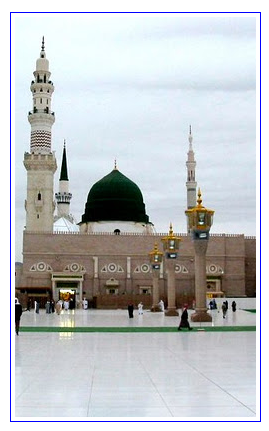


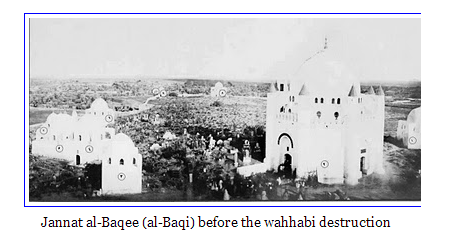
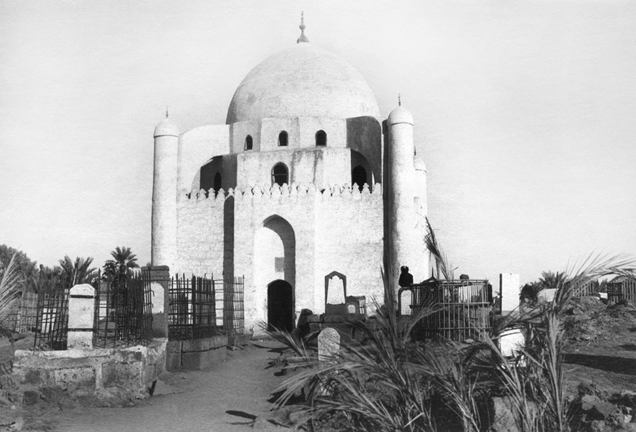
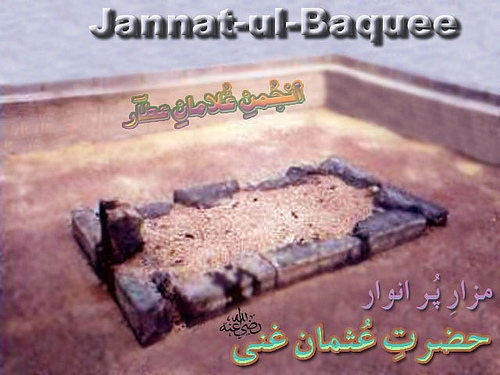

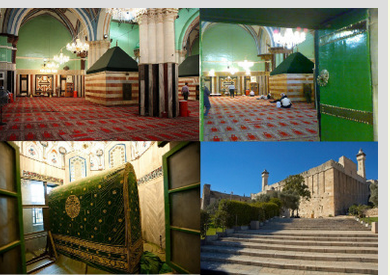

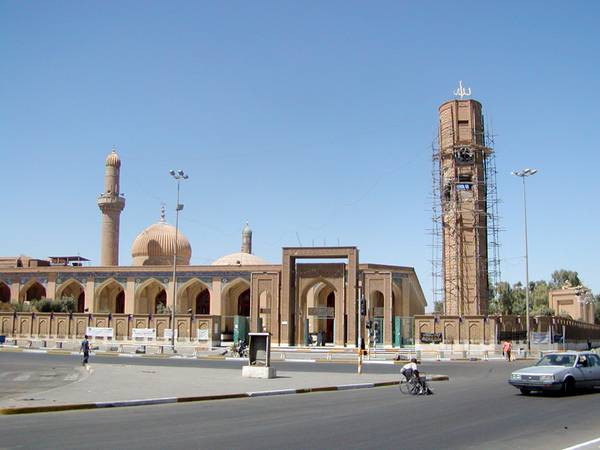
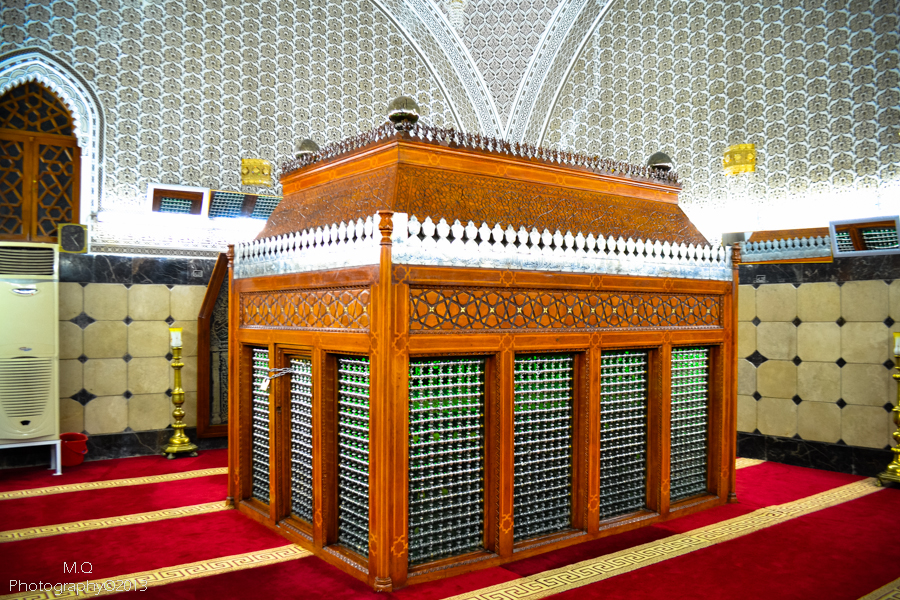
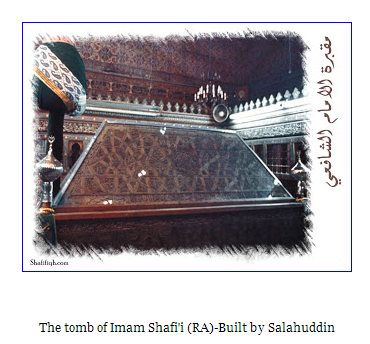
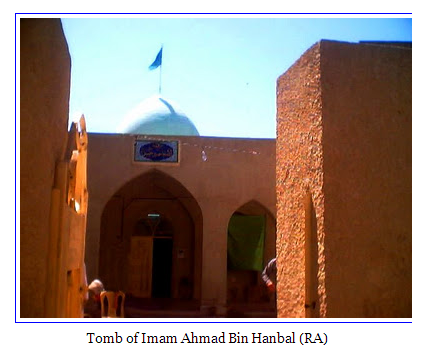
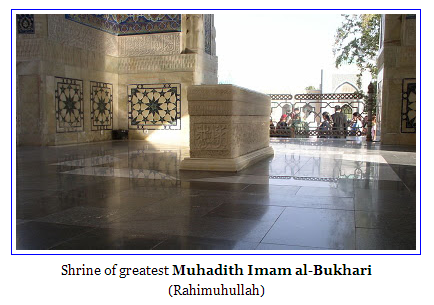
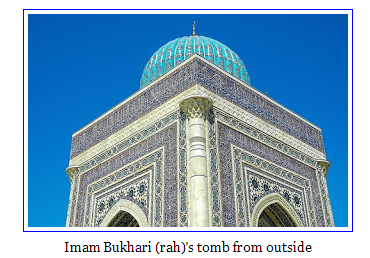

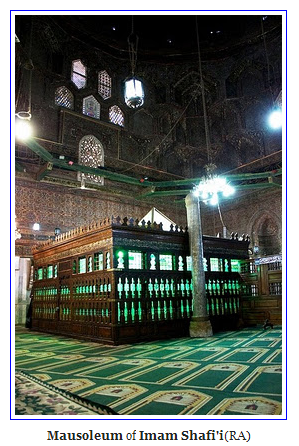

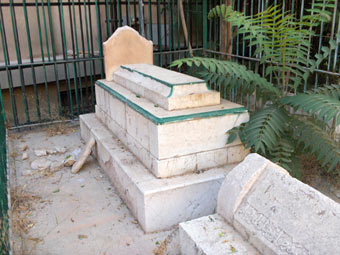
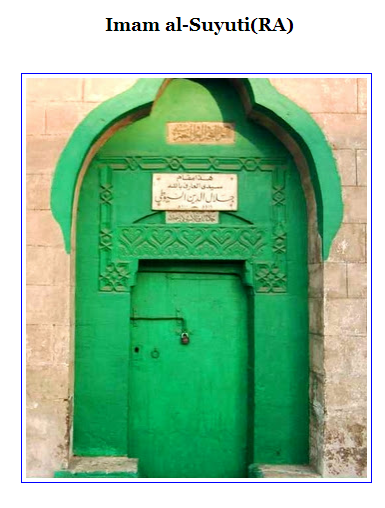

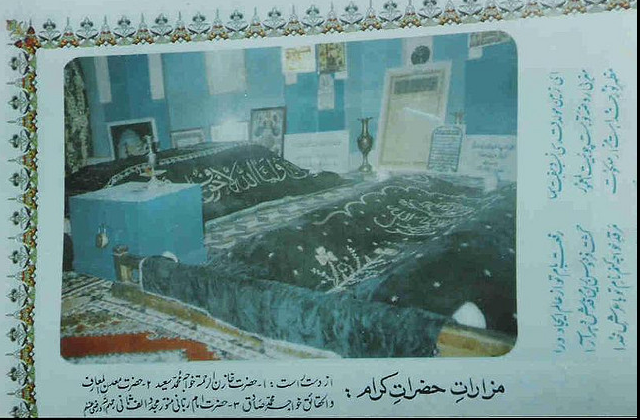
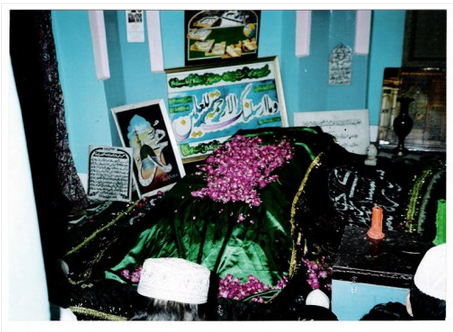
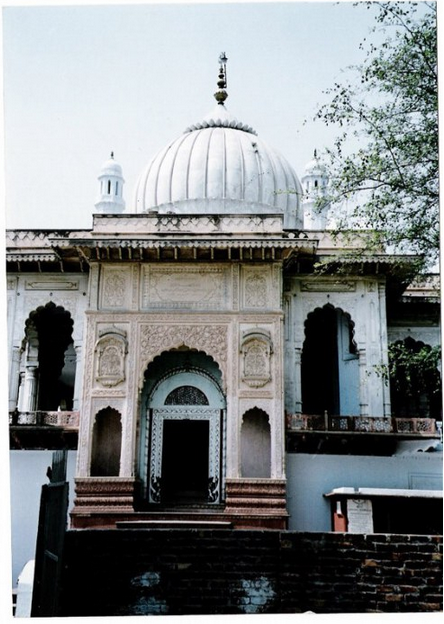
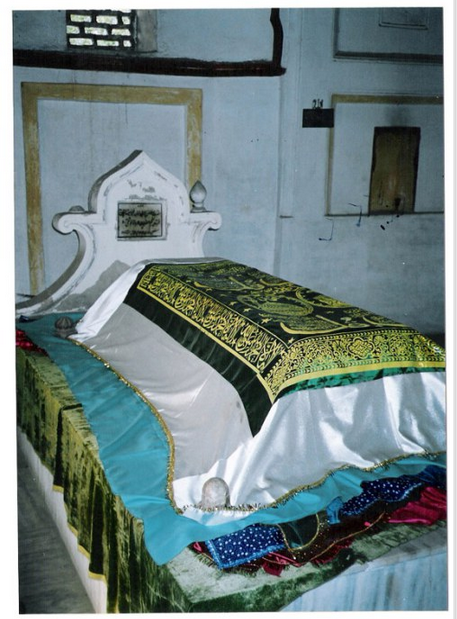
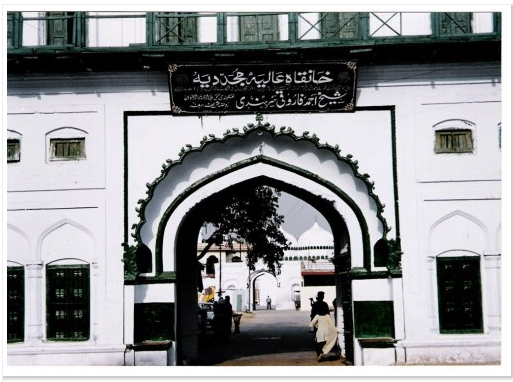
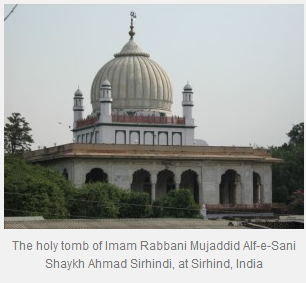

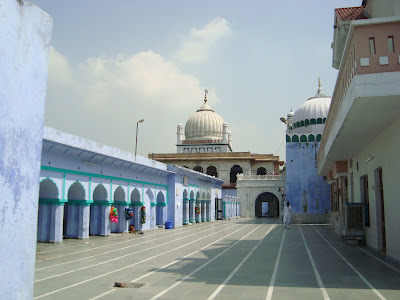
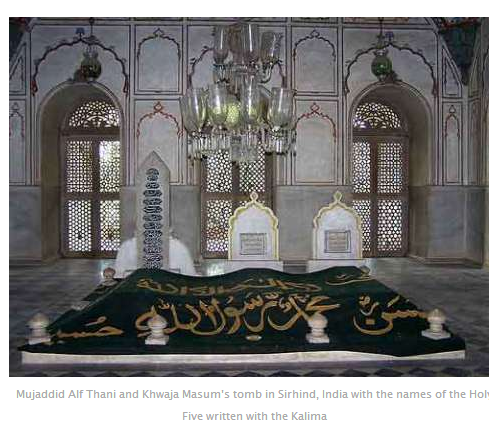
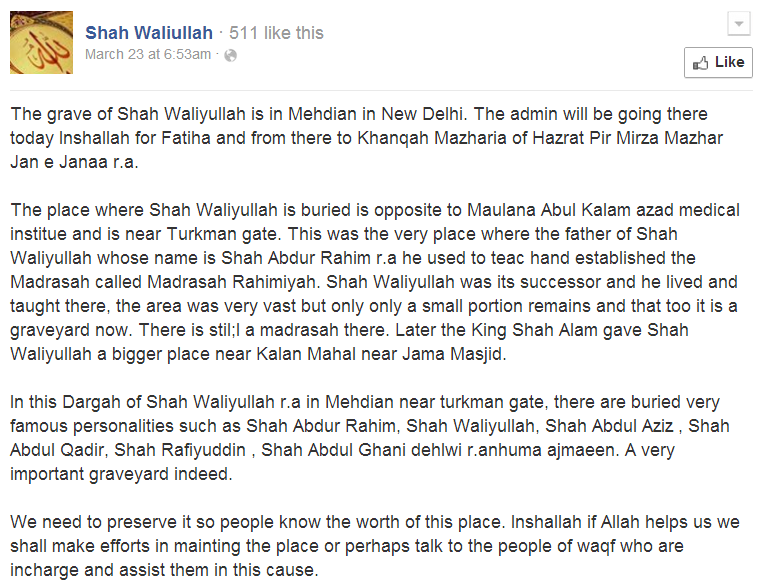

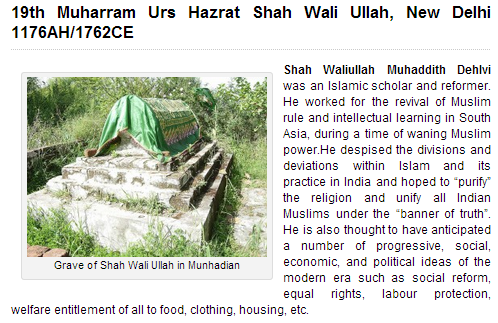

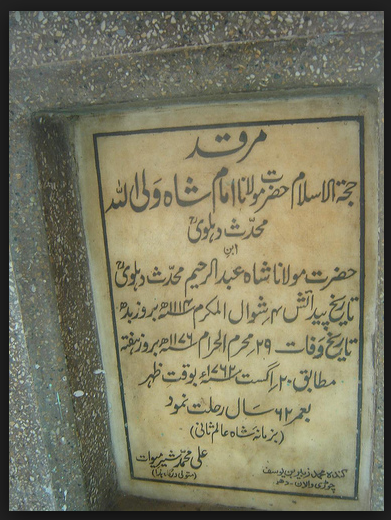
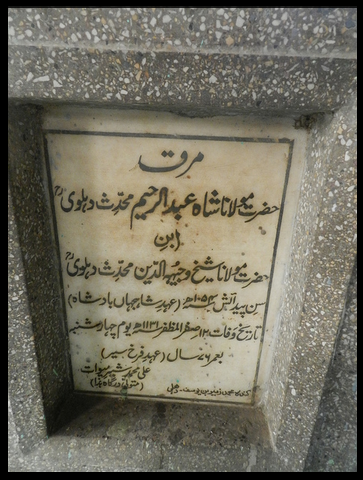
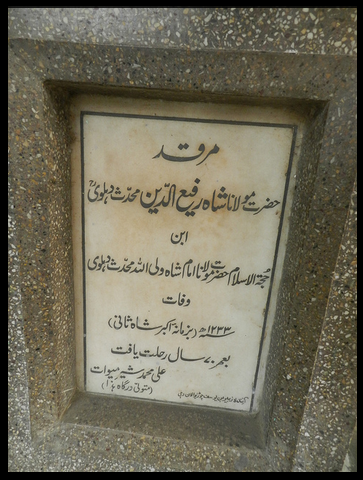


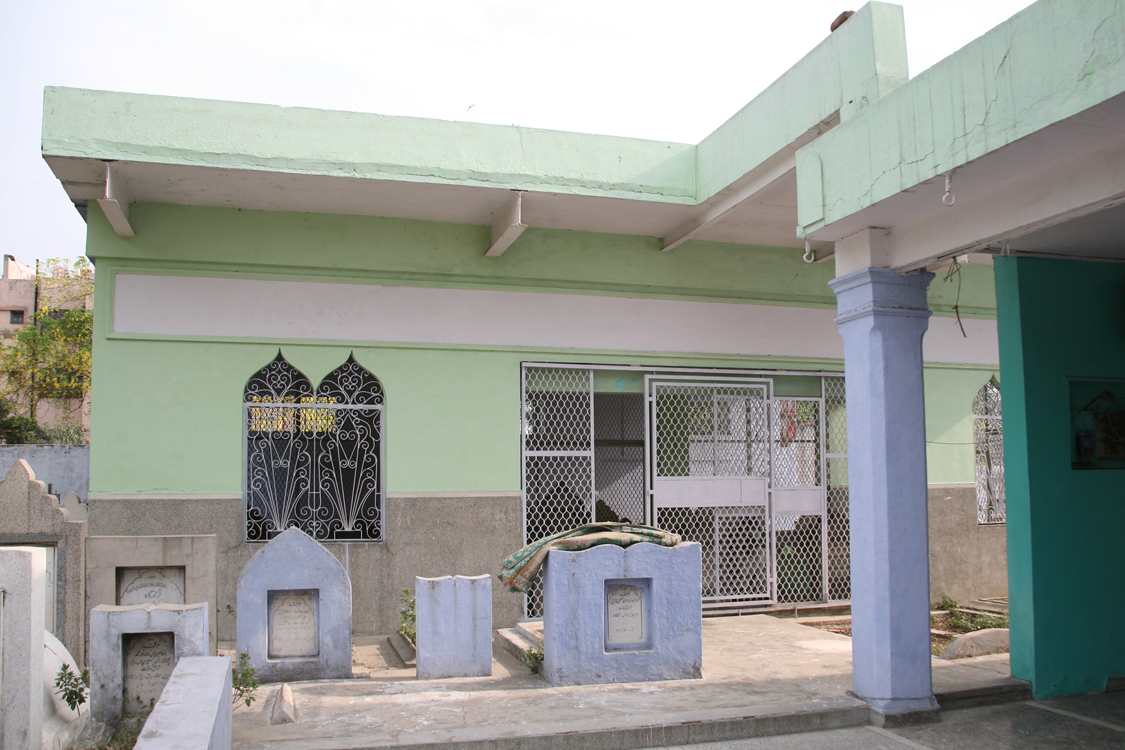




Shrines/Tombs and Graves
It is a Sunnah to build tombs/shrines around the graves of Prophets (alaih salam) ,Salafs (RA) and Awliya al-Ikraam (rah).
Although for public graveyards and ordinary Muslims it is not allowed:
^Muslim Cemetery- Sarajevo
^Muslim cemetery – Pakistan – Quetta – Baluchistan
^Muslim Cemetery – Hong Kong
—
The First Tomb in Islam
^(Early Illustration )
a. Prophet’s mihrab
b. Aisha b. Abu Bakr’s RA residence
c. Hafsa b. Umar’s RA residence
d. Zainab b. Jahsh’s RA residence (not pictured)
e. Zainab b. Kuzayma’s RA) residence (not pictured)
f. Fatima’s RA residence (not pictured)
g. Baab-Uthman b. Affan RA
h. Ahlul Suffa Residence
i. Juwayriya’s RA residence (not pictured)
j. Rumla’s RA residence (not pictured)
k. Saffiya’s RA residence (not pictured)
l. Baab-ul-Rahma
m. Abu Bakr’s RA residence
n. Sa’d b. Abi Waqaas RA residence (not pictured)
o. al-Abbas b. Abdul Muttalib RA (Prophet’s SAWS uncle) residence
p. Jafar b. Abi Sadiq RA residence
Source: The Madinah Research & Study Centre, Al Madinah Al Munawara
The Blessed Grave of the Holy Prophet Muhammad (Peace be upon him) is “INSIDE” room of the house of Ayesha (ra)
The Second Tomb in Islam
Grave of Sayyidna Abu Bakr (RA) is in a room of the house of Ayesha (ra) buried next to Prophet (Peace be upon him)
The Third Tomb in Islam
Grave of Sayyidna Umar Ibnul Khattab (ra) is in a room of the house of Ayesha (ra) buried next to Prophet (Peace be upon him) and Abu Bakr (ra)
So it was a practice of Sahaba to bury Prophet (PBUH) and Caliphs not openly but inside a Room or in other words a “CONSTRUCTED SHRINE”
—
Misquotation of Hadith
Sahih Muslim Volume 2, Book 23, Number 414
Hadith states:
Narrated by ‘Urwa:
Aisha said, “The Prophet in his fatal illness said, ‘Allah cursed the Jews and the Christians because they took the graves of their Prophets as places for praying.”
‘ Aisha added, ” Had it not been for that the grave of the Prophet (PBUH) would have been made prominent but I am afraid it might be taken (as a) place for praying.
The above hadith is quoted for Jews and Christians not for Muslims, who took their Prophets as God, Son/daughter of God.
(Ethiopian Christians worship Orthodox Church at the holy Sepulcher Church in Jerusalem)
(Christian Women worship at the Church of the holy Sepulchre)
Imam Ibn Hajar al- Haytami (in his Zawajir) quotes the hadith from Ahmad, Bukhari and Muslim that the Prophet (Allah bless him and give him peace) said:
“May Allah curse the Jews and Christians; they have taken the tombs of their prophets as places of worship.”
^(Pope)
Imam Ibn Hajar al- Haytami said, “The reason for considering it an enormity is obvious
He explains, however, that, “Taking a grave as a place of worship means to pray on the grave or towards it. The prohibition, moreover, applies exclusively to the grave of someone venerated… under the two conditions:
A) That the grave is of someone who is honoured and venerated;
B) And that the prayer is performed towards or on the grave with the intention of gaining the blessing of it, or out of reverence for it. (from: al-Zawajir, Reliance w21)
And this is only if one prays so close to it that if praying the prayer of those attentive (looking down), the grave would be within one’s sight. [End quote]
^(WORSHIP AT ST. LAIKA’S)
Worshipping and doing sajda in front of grave/idol as the ^Christians/Jews is Haram!
—
Quran states
Thus did We make their case known to the people, that they might know that the promise of Allah is true, and that there can be no doubt about the Hour of Judgment. Behold, they dispute among themselves as to their affair. (Some) said, “Construct a building over them”: Their Lord knows best about them: those who prevailed over their affair said,”Let us surely build a place of worship over them.” (Quran 18:21)
Ashab al kahf
Authentic classical Tafsir for this verse:
Qadhi Thana Ullah Panipatti (Rahimuhullah) writes in his great Tafsir al Mazhari: After the death of Ashaab al Kahf a dispute occurred between Muslims and non-muslims, The Muslims said that they will make a Masjid over them because they were of our faith whereas the disbelievers said they will build other buildings on it where people will live….
Mausoleum of Imam Shafi’i(RA)
This Ayah is proving that Mosques could be made near graves of Awliya in order to say salaat in them, Tabarruk is also attained through the tombs of Awliya[Tafsir al Mazhari Volume No.7, Page No. 123-124]
Tafsir by Imam Bayzawi (rah) says: “From this it is understood that to erect a Mausoleum for the special people, i.e. Pious Saints and Ulema, is permissible”.
Tafsir by Imam Fakhrud’deen Razi (rah) writes:
أن بعضهم قال: الأولى أن يسد باب الكهف لئلا يدخل عليهم أحد ولا يقف على أحوالهم إنسان. وقال آخرون: بل الأولى أن يبني على باب الكهف مسجد وهذا القول يدل على أن أولئك الأقوام كانوا عارفين بالله معترفين بالعبادة والصلاة
Translation: Some people said that the door of the cave should be closed so that nobody can enter it and the Ahwaal (of Ashab e Kahf) are kept hidden. Some people said that It is better to build a mosque at the door, this saying proves that these people were “ARIFEEN OF ALLAH WHO BELIEVED IN WORSHIPPING AND PRAYER” [Tafsir al Kabeer, Volume No. 5, Page No. 475]
Imam al-Razi also said:
ثم قال تعالى: {قَالَ ٱلَّذِينَ غَلَبُوا۴ عَلَىٰۤ أَمْرِهِمْ} قيل المراد به الملك المسلم، وقيل: أولياء أصحاب الكهف، وقيل: رؤساء البلد: {لَنَتَّخِذَنَّ عَلَيْهِم مَّسْجِدًا} نعبد الله فيه ونستبقي آثار أصحاب الكهف بسبب ذلك المسجد
Translation: And when Allah said {Those who prevailed over their affair} this refers to the “MUSLIM RULER” or the Awliya of Ashaab al Kahf (i.e. their momineen friends) or the leaders of town. {We will surely build a Mosque over them} so that we can “WORSHIP ALLAH” in it and due to it we will
“PRESERVE THE RELICS OF ASHAAB AL KAHF” [Tafsir al-Kabeer, 5/475]
In “Tafseer Roohul Bayaan”, Vol. 3, according to the verse: “To build over the graves of the Ulema, Awliya and the Saliheen is a permissible act with this condition that the motive is that the greatness of these pious people must be made apparent so that the people don’t think that it is an ordinary grave.”
Imam Hakim (Rehmatullah Alaih) said in his Tafsir:
قال الذين غلبوا على أمرهم} وهم المؤمنون, وكانوا غالبين في ذلك الوقت
Translation: {Those who prevailed over their affair} refers to the “MOMINEEN” and they prevailed over this matter in that time [Tafsir al Wahidi under 18:21]
Imam Jalal ud-din Suyuti (Rehmatullah Alaih) and Al Muhalli (Rehmatullah Alaih) explain in Tafsir al Jalalyn:
يَتَنَـٰزَعُونَ} أي المؤمنون والكفار {بَيْنَهُمْ أَمْرَهُمْۖ} أمر الفتية في البناء حولهم {فَقَالُوۤا۴} أي الكفار {ٱبْنُوا۴ عَلَيْهِم} أي حولهم {بُنْيَـٰنًاۖ} يسترهم {رَّبُّهُمْ أَعْلَمُ بِهِمْۚ قَالَ ٱلَّذِينَ غَلَبُوا۴ عَلَىٰۤ أَمْرِهِمْ} أمر الفتية وهم المؤمنون {لَنَتَّخِذَنَّ عَلَيْهِم} حولهم {مَّسْجِدًا} يصلى فيه، وفعل ذلك على باب الكهف.
Translation: They were disputing, that is, the believers and the disbelievers, among themselves their affair, the affair of the youths, with regard to building something around them [as a monument]; so they, the disbelievers, said, ‘Build over them, that is, around them, a building, to cover them up; their Lord knows them best.’ Those who prevailed regarding their affair, the affair of the youths, “NAMELY THE BELIEVERS”
We will verily set up over them, around them, a place of worship’, for prayers to be performed therein. And this indeed took place at the entrance of the cave. [Tafsir al Jalalyn, Volume No.1, Page No. 389]
Imam Nasafi (Rehmatullah Alaih) writes in his Tafsir al Nasafi:
قَالَ ٱلَّذِينَ غَلَبُوا۴ عَلَىٰۤ أَمْرِهِمْ} من المسلمين وملكهم
وكانوا أولى بهم وبالبناء عليهم {لَنَتَّخِذَنَّ عَلَيْهِم} على باب الكهف {مَّسْجِدًا} يصلي فيه المسلمون ويتبركون
Translation: {Those who prevailed over their affair} these are the “MUSLIMS AND THE RULERS” who said to build over them i.e. on the door of cave a Masjid so that“MUSLIMS CAN PRAY IN IT AND SEEK TABARRUK” [Tafsir al Nasafi, Volume No.3, Page No. 18]
Imam Abu Hayyan al Andalusi (Rehmatullah Alaih) said:
وروي أن التي دعت إلى البنيان كانت كافرة أرادت بناء بيعة أو مصنع لكفرهم فمانعهم المؤمنون وبنوا عليهم مسجداً
Translation: The person who told to make a building over them was a Kafir woman, she told to make a Church over them where deeds of Kufr can take place, however the momineen stopped her and made a Masjid over there instead [Tafsir Bahr al Muheet, Volume No. 7, Page No. 158]
Imam Ibn Jawzi (Rehmatullah Alaih) who is considered one of the most strictest scholar and revered highly by Salafis, he states in his Tafsir under 18:21
قال ابن قتيبة: يعني المُطاعين والرؤساء، قال المفسرون: وهم الملك وأصحابه المؤمنون اتخذوا عليهم مسجداً
Translation: Ibn Qutayba (Rehmatullah Alaih) said that the Mufasireen said: People who made Masjid were the (Muslim) King and his Momineen companions [Tafsir Zaad ul Maseer, Volume No. 5, Page No.124]Imam Shahab ud-din Khafaji (Rehmatullah Alaih) wrote:
مسجد ايدل على جوازا لبناء على قبور الصلحاء ونحوهم كما اشار الي فى الكشاف وجواز الصلوة فى ذلك البناء
Translation: (Making mosque on cave) ”IS PROOF OF MAKING MOSQUES OVER THE GRAVES OF SALIHEEN” just like It is mentioned in Tafsir al Kashaaf and It is “PERMITTED” to pray inside this construction [Imam Khafaji in Inayatul Qadhi, Volume No. 6, Page No. 87, Published by Dar us Sadir, Beirut, Lebanon]
Mullah Ali Qari (Rehmatullah Alaih) writes:
أما من اتخذ مسجدا في جوار صالح أو صلى في مقبرة وقصد الإستظهار بروحه أو وصول أثر ما من أثر عبادته إليه لا للتعظيم له والتوجه نحوه فلا حرج عليه ألا ترى أن مرقد إسماعيل عليه السلام في المسجد الحرام عند الحطيم ثم أن ذلك المسجد أفضل مكان يتحرى المصلى لصلاته والنهي عن الصلاة في المقابر مختص بالقبور المنبوشة لما فيها من النجاسة كذا ذكره الطيبي وذكر غيره أن صورة قبر إسماعيل عليه السلام في الحجر تحت الميزاب وإن في الحطيم بين الحجر الأسود وزمزم قبر سبعين نبيا
Translation: Anyone who builds a mosque near the grave of an upright person or prays in the tomb (Maqbara) or intends to ask for help through the Ruh of that upright person or intends to seek barakah from his left overs, If he does all that without the intention of giving him Tazeem or doing tawajuh towards him ( in prayer) “Then there is nothing wrong in that, don’t you see that Grave of Hadrat Ismail(A.S) is inside the Masjid ul Harram near the hateem and to Pray there is Superior than anything else ” however to pray near the graves is only forbidden when the soil becomes dirty because of Najasat of deceased… In the Hateem near Hajr al Aswad and Mizaab there are “Graves of 70 Prophets” [Mirqat, Sharh al Mishqaat, Volume No. 2, Page No. 202]
Mullah Ali Qari (Rehmatullah Alaih) also said:
وقد أباح السلف البناء على قبر المشايخ والعلماء المشهورين ليزورهم الناس ويستريحوا بالجلوس فيه
Translation: The early Muslims (Salaf) have considered it Mubah (i.e. allowed) to build over the graves of famous Mashaikh and Ulama so that people can visit them and sit there (easily) [Mirqaat Sharh al Misshqaat, Volume No. 4, Page No. 69]
So Indeed the Prophets, Mashaikh and Saliheen do not come under the prohibition because the grave of Prophet (Peace be upon him), Abu Bakr (Radhi’Allah anho), Umar (Radhi’Allah anho) and many other Prophets and Saliheen have remained “BUILT OVER”
The tomb of Prophet Yahya(AS)
Ibn khatir in his tafsir writes.
م { قَالَ ٱلَّذِينَ غَلَبُواْ عَلَىٰ أَمْرِهِمْ لَنَتَّخِذَنَّ عَلَيْهِمْ مَّسْجِدًا } حكى ابن جرير في القائلين ذلك قولين: [أحدهما] أنهم المسلمون منهم.
Translation: “When the people of the cave went into the cave, some people close to the entrance of the cave said, ‘Build a mosque so we can worship Allah.’ The people who said this were Muslims” [Tafsir Tabari, Tafsir Ibn Kathir, Sura al-Kahf, verse 21]
—
Imam Ibn Hajr al Asqalani (rah) writes in his magnificent Fath ul Bari:
In view of the fact that the Jews and Christians were taking the graves of their Prophets as their qibla for the purpose of respect, and were paying attention towards them at the time of their prayers, their graves took the position of idols. For this reason the Muslims have been forbidden from this action. However, if someone constructs a mosque near the grave of a pious person for the purpose of seeking tabarruk and not for prostration or paying attention towards them, he will never be included in this prohibition. ( Ibn Hajr al-‘Asqalani, Fath al-bari, vol. 3, p. 208)
—
Building of Tombs around a Grave
Hadrat Umar (Ra) wish to get buried beside Tomb of Prophet (PBUH) in a Room !
Al-Bukhari narrates in his Sahih, Book of Jana’iz:
When `Umar was stabbed he sent his son `Abd Allah with a message to `A’isha to”Ask her if I can be buried with my two companions,” that is, in her room, next to the Prophet and Abu Bakr. `A’isha replied: “I wanted the spot for myself, but I shall put him [`Umar] before me today.” It had been her habit that if a man from among the Companions asked her that spot she would always refuse. She herself gave the following instructions before her death: “Bury me with my lady-friends (the wives of the Prophet in al-Baqi`) [but do not bury me with the Prophet in the house, for I dislike to be held in reverence (inni akrahu an uzakka).” Ibn `Umar came back with the news, whereupon `Umar said: “NOTHING IN THE WORLD WAS MORE IMPORTANT TO ME THAN THAT RESTING-PLACE.” [Narrated by al-Bukhari in his Sahih.]
Why did Hadrat Umar (ra) wanted to get buried in a room and not outside, Why is Hadrat Abu Baker (Ra) buried in a Room , A tomb is also a room built around the grave ,and it proves it’s a sunnah
The Tomb of Holy Prophet (صلی اللہ علیھ وآلھ وسلم) is the greatest proof of this practice , Other tombs of Sahabas (Ra) were demolished by Al Saud otherwise they too were present throughout history of Islam.
Hadith proving Tombs of 70 Prophets (AS)
5769- وعن ابن عمر أن النبي صلى الله عليه وسلم قال:
”في مسجد الخيف قبر سبعون نبياً”.
رواه البزار ورجاله ثقات.
Narrated by Ibn Umar (RA) from Prophet (salallaho alaihi wasalam) who said: In (fi) the Mosque of al-Khayf there is Qabr of 70 Prophets (together)
Imam al Hafidh Ibn Hajr al Haythami (rah) said: رواه البزار ورجاله ثقات
It is narrated by Al-Bazzar and all its narrators are “THIQA” (i.e. Hadith is absolutely sahih) [Majma az Zawaid Volume No.3, Page No.640 Bab fi Masjid al Khayf, Hadith #5769]
Hazrat Esa (pbuh) Jesus Will Be Burried Next to our Prophet’s (may God bless him and grant him peace) Tomb
Jesus, son of Mary, will come down to the world… He will marry, . . . live for 45 years and then die. He will be buried with me [Mohammed] in my grave. Then I and Jesus, son of Mary, will stand up in one grave between Abu Bakr and `Umar. (Mishkat-ul-Masabih, 40:4)
Jesus will marry and have a child after he returns. After he dies, the Muslims will perform his funeral prayer and bury him at the Rauza-i-Aqdas (Ibn Hajar al-Haythami, Al-Qawl al-Mukhtasar fi `Alamat al-Mahdi al-Muntazar, 65)
This hadith itself proves that Hadrat Esa (aleh islam) will be buried in Prophet (صلی اللہ علیھ وآلھ وسلم) Tomb along with him
—
Abu Bakr Al Faqih has related from the Holy Prophet (صلى الله عليه وسلم) that he said:
“There was no prophet who escaped from his people that he did not come to Makkah and worshipped Allah till he died. And there are the graves of Hud, Shuyab and Saleh and between Zamzam and Maqam and in the Kaaba there are the graves of 300 prophets. Between ‘Rukn Yamani’ and ‘Rukn Aswad’ are the graves of 70 prophets.
محمد قال :اخبرنا ابو حنيفة قال حدثنا
عطاء بن الساءب قال :قبر حود وصالح وثعيب عليحم السلام في المسجد الحرام
Muhammad said: Abu Hanifa informed us saying that Ata ibn as Saib narrated to us saying the graves of Prophet Hud, Salih and Shuaib [aleh islam] is in Masjid Al Haram
[In pg 150,Kitab al-Athar of Imam al-Shaybani as published by Turath Publishing in London]
—
Prostrating towards a grave
(doing sajda)
This is clearly Haram even if sajda e tazeemi , Sunni Muslims do not believe in doing Sajda towards a grave as Shariah prohibits it .
Miskat ul Mabasih page 161 Vol 1 hadith 694:و عن عطا ء بن ىسار قال قال رسؤل الله صلی اللہ علیھ وآلھ وسلمااللهما كا تجعل قبرى وثنا يعبد اشتد غضب الله علئ قوم اتخز وا قبور انبيا حى ام مسا جد رواحما لق مرسلق
Hadrat Ata Bin Siyar narrated that Prophet (صلی اللہ علیھ وآلھ وسلم) said that do not make my grave an idol after I die may Allah curse this nation who made graves of their Prophets (as) into prostration places (worship places)
The Messenger of Allah (صلى الله عليه وسلم) said:
“O Allah, do not make my grave an idol to be worshipped after me. Allah was very angry with people who took the graves of their Prophets as places of worship”.
(Malik, 593, Bukhari, 3765,…etc)
Yahya (رضئ اللہ تعالی عنہ) related to me from Malik (رضئ اللہ تعالی عنہ) from Zayd ibn Aslam (رضئ اللہ تعالی عنہ) from Ata ibn Yasar (رضئ اللہ تعالی عنہ) that the Messenger of Allah(صلى الله عليه و آله وسلم) said, “O Allah( سبحانہ و تعا لی )! Do not make my Grave an idol that is worshiped. The anger on those who took the Graves of their Prophets as places of prostration was terrible.” (Muatta’ Imâm Malik – Book #9,Hadith #9.24.88)
Christians and Jews associated divinity with their Prophets and made Churches and Prayer halls over the graves of their Prophets. In the above Ahadith Prophet Mohammad (صلى الله عليه و آله وسلم) is referring to that practices and warning Muslims never to follow the footsteps of Jews and Christians.
Here above strictness forbidding prostration is narrated in the hadith , and by making places of worshipping it means making it prostration place, this has already been mentioned by Imam ibn e Hajar (Rah) … so any one who does Sajda to is haram, any muslims who does it is not follow ahle sunnah wal jammat
—
Kissing a Grave or putting head on Grave
It is also narrated that Mu`adh ibn Jabal and Bilal came to the grave of the Prophet and sat weeping, and the latter rubbed his face against it.”
► Ibn Majah 2:1320, ►Ahmad, ►al-Tabarani, ►al-Subki, and Ibn `Asakir
Dawud ibn Salih said: “[The governor of Madina] Marwan [ibn al-Hakam] one day saw a man placing his face on top of the grave of the Prophet. He said: “Do you know what you are doing?” When he came near him, he realized it was Abu Ayyub al-Ansari. The latter said:
“Yes; I came to the Prophet, not to a stone.,
► Ibn Hibban in his Sahih,►Ahmad (5:422), ►Al-Tabarani in his Mu`jam al-Kabir (4:189) and his Awsat according to Haythami in al-Zawa’id (5:245 and 5:441 #5845 Book of Hajj, “Section on the honoring of the dwellers of Madina, chapter on placing one’s face against the grave of our Master the Prophet ” and #9252 Book of Khilafa, “Chapter on the leadership of those unworthy of it”), ►al-Hakim in his Mustadrak (4:515);► both the latter and al-Dhahabi said it was sahih.► It is also cited by al-Subki in Shifa’ al-siqam (p. 126) ►and Ibn Taymiyya in al-Muntaqa (2:261f.)
—
The Blessed Tomb of
Holy Prophet (صلی اللہ علیھ وآلھ وسلم)
al-Dhahabi said: “Ahmad ibn Hanbal was asked about touching the Prophet’s grave and kissing it and he saw nothing wrong with it. His son ‘Abd Allah related this from him. If it is asked: “Why did the Companions not do this?”
We reply: “Because they saw him with their very eyes when he was alive, enjoyed his presence directly, kissed his very hand, nearly fought each other over the remnants of his ablution water, shared his purified hair on the day of the greater Pilgrimage, and even if he spat it would virtually not fall except in someone’s hand so that he could pass it over his face.Since we have not had the tremendous fortune of sharing in this, we throw ourselves on his grave as a mark of commitment, reverence, and acceptance, even to kiss it.
Do you not see what Thabit al-Bunani did when he kissed the hand of Anas ibn Malik and placed it on his face saying: “This is the hand that touched the hand of the Messenger of Allah “? Muslims are not moved to these matters except by their excessive love for the Prophet , as they are ordered to love Allah and the Prophet more than their own lives, their children, all human beings, their property, and Paradise and its maidens. There are even some believers that love Abu Bakr and ‘Umar more than themselves. [Al-Dhahabi, Mu’jam al-Shuyukh (1:73 #58).]
“‘Abd Allah ibn Ahmad said: “I saw my father take a hair that belonged to the Prophet , put it on his mouth, and kiss it. I believe I saw him put it on his eyes. He also dipped it in water and drank the water to obtain cure. I saw him take the Prophet’s bowl (qas’a), wash it in water, and drink from it. I saw him drink Zamzam water in order to seek cure with it, and he wiped his hands and face with it.” I say: Where is the quibbling critic of Imam Ahamad now?
It is also authentically established that ‘Abd Allah asked is father about those who touch the pommel of the Prophet’s e pulpit and touch the wall of the Prophet’s e room, and he said: “I do not see any harm in it.” May Allah protect us and you from the opinion of the Khawarij and from innovations!
[ Al-Dhahabi, Siyar A’lam al-Nubala’ (9:457). Ch. on Imam Ah.mad, section entitled Min adabih]
—
NOTE from Ala Hadrat Imam Ahmed Raza Khan (rah)
Even after above Sahih hadiths and opinion of salafs Mujadad Ala Hadrat Imam Ahmed Raza khan (rah) said,
He states: there are diverse opinions amongst the scholars regarding kissing graves. It is an act which lies between two things: something that allows the practice: love and something that disallows it: adab respect. Hence, the one who does it through overwhelming love is not criticized because this act is proven from the sahabah.
Though, it is better for the general public to be precautious.] Our scholars have explicitly stated that one should stand at least four feet away from the grave, so how would one kiss it!? (Fatwa Ridhwiyah, 9:528)
Doing Tawaaf of Graves
This is also not allowed and haram according to Ahlus Sunnah viewpoint!
Fatwa from Ala Hadrat Imam Ahmed Raza Khan (rah)
QUESTION: What do the Ulamaa-e-Deen and Muftiyaane Share-Matin say regarding kissing the grave of Awliyaa-e-Kiraam and doing the tawaaf of the grave and doing sajdah before the grave (give written answer and earn sawaab)
ANSWER: No doubt doing the tawaaf of anything else except the Kaabah Muazzamah is unlawful [haram] . Sajdah (prostration) in front of anyone else except Allah is forbidden in our Shariat and about kissing the grave there are differences about it among the Ulamaas it is better not to do it (Do not kiss).Especially about the grave of the Awliyaa-e-Kiraam our Ulamaa have clearly described that we should stand quite far from the grave, the distance between us and the grave should be of four feet. This is the real respect then how can kissing of the grave be even thought of? (Ahkaame Shariat part 3 pg.3-4)
Urdu scanned Pages ( Click Here )
—
Narrated Aisha(ra)
Um Salama told Allah’s Apostle about a church which she had seen in Ethiopia and which was called Mariya. She told him about the pictures which she had seen in it. Allah’s Apostle said, “If any righteous pious man dies amongst them, they would build a place of worship at his grave and make these pictures in it; they are the worst creatures in the sight of Allah.” [sahih bukhari volume 1, number 426]
^Maria, Church, Lalibela, Ethiopia
First thing to be noted is ahle sunnah wal jammat considers putting pictures at graves is Haram.
Imam Ibn e Hajar (Rah) there is not a single Imam who took worshiping as building shrines except some deviated people, As QURAN ITSELF SAYS THEY BUILD A PLACE OF WORSHIP AND EVEN MASJID NABWI (صلی اللہ علیھ وآلھ وسلم) is a Place of Worship !
Making pictures is Haram and has no justification!
Secondly this hadith is stated for Christians and non muslims, And some people blindly quote such hadiths and verses for Muslims!
—
Hadith of Visiting only 3 Mosques is allowed?
Narrated Abu Huraira: The Prophet said, “Do not set out on a journey except for three mosques, i.e. Al-Masjid-Al-Haram, the Mosque of Allah’s Apostle, and the Mosque of Al-Aqsa (Mosque of Jerusalem).” [Sahih bukhari volume 2,number 281]
Some people take this hadith literally to claim that going to any mosque or Shrine is Haram , According to this childish logic we see
► All scholars who go to any mosque in the world to give lectures or pay visits (which many do every year including wahabi(ghair muqaled) school scholars) are doing a haram act
IMAM NAWAWI ON THIS HADITH quoting Salafs
Imam Nawawi write in Sharah of hadith ‘Not to travel (for visiting) except for three mosques (Bukhari)’ the true meaning of hadith, He (Nawawi) Write:
In this haidth the Three Mosques status and thier high status as compaired to other mosques in the world is mentioned, because these are mosques of the Prophets (may Peace Be Upon Him) and this is why offering salat in them has greater blessing. (he writes more that many ulemas have different viewpoint regarding going to Graves and going to these three Mosques)
Near our Masters (i.e Shafi’I) right Concept is that those to whom Imam al-Harmain (Abu al-Mali Abdul Malik al-Jiyoni) and other researches of islam have permitted for them its neither Haram not Makruh to visit grave (qaboor) for Ziyarah, According to them it means that to go for a journey for Sawab having intentions of complete and utmost blessing is only permissible for these three mosques. [Sharah Sahih Muslim, Nawawi, Volume 009, Page No. 106]
—
^Ibn Taymiyah said
He said “It is also mustahabb (recommended) to visit the graves of the people of al-Baqee’ and the martyrs of Uhud, to pray for them and ask for forgiveness for them,because the Prophet (peace and blessings of Allaah be upon him) used to do this, but this is prescribed for all the Muslim graves.” (Majmoo’ al-Fataawa, 17/470)
Jannat al-Baqee (al-Baqi) before the wahhabi destruction
—
Visiting Mosque of Quba apart from 3 Mosques
For those who still after views of Imam Nawawi Rah take that hadith literally ,
The hadeeth narrated in al-Saheehayn from Ibn ‘Umar (may Allaah be pleased with him) who said: “The Prophet (peace and blessings of Allaah be upon him) used to come to Quba’ riding and walking.” According to another report: “and he would pray two rak’ahs there.” (narrated by al-Bukhaari and Muslim).
The Prophet (peace and blessings of Allaah be upon him) also said, “Whoever purifies himself in his house then comes to the mosque of Quba’ and prays there, he will have a reward like that for ‘Umrah.”
references:
►Narrated by Ahmad,
►al-Nasaa’i,► Ibn Maajah
►and al-Haakim. Al-Haakim classed it as saheeh and al-Dhahabi agreed with him►
Also classed as saheeh by al-Albaani in Saheeh al-Jaami’, 6154
this proves that the hadith of only visiting three moques if taken literally is illogical , As Sahabas (Ra) used to Visit janat ul baqi and also visiting Masjid e Quba is recommended
—
Hadith of Sahih Muslim on
Building over the Grave
—
Regarding Hadith of Sahih Muslim And it was narrated that Jaabir (may Allaah be pleased with him) said:
The Prophet (peace and blessings of Allaah be upon him) forbade plastering over graves, or sitting on them or building over them. Both reports were narrated by Muslim in his Saheeh
Ultra-Orthodox Jewish Man on Top of Grave of Rabbi Shimon Bar Yochai
Sitting over not around ,the graves is forbidden and no one sits on as grave, I never saw a sane muslim doing it ,Similarly the Dome is like a room build around not over a grave and this has been proved from above what Prophet (صلی اللہ علیھ وآلھ وسلم) and first two caliphs(ra) of Islam were themselves buried in a room not in a open grave.
By building over them it means structures made over them (not around ) during time of ignorance, Muslims build tomb or shrine around it
Examples of building over
the grave by Christians and Jews
^Palestinian Christian cemetery
^Christian Cemetery
^Jewish cemetery
^This is what is meant by building over the graves
—
Building Around the Grave
Muslims build shrines around not over the graves,This is how Shrine of our Prophet Muhammad (salehalawaalihiwasalam) is, and this is how all shrines are built.
Wahabis/Salafis need to take English and Arabic lessons to understand the difference between Over and Around
Examples of building over the grave by Christians and Jews, Muslims do not do it!
We hope this extreme misquotation of Hadith is cleared, otherwise Quran which is absolute Hujjah proves as shown in tafsirs above.
Building Mosque over a grave
Sunan Dawud Book 20 Hadith 3230 says:
Narrated Abdullah ibn Abbas:
The Apostle of Allah (PBUH) cursed women who visit graves those who built mosques over them and erected lamps
This hadith can be explained by a simple logic that even Prophet Muhammad’s grave is inside a Mosque!
Not in the main hall where Salat is offered but according to the most famous and respected historian Ibn kathir
Imam at-Tabari and Hafiz Ibn Kathir write,
In 88 AH, that the room of ‘A’isha (may Allah be pleased with her) – where there are graves of the Prophet Muhammad (may Allah bless him and grant him peace), Abu Bakr and ‘Umar (may Allah be pleased with them)- was joined to the mosque of the Prophet
Reference:
[Tareeh Tabari and Tar’ikh Hafiz Ibn Kathir, Chapter of Government of Walid ibn ‘abd al-Malik]
This does not only answers right from Sunnah point of view but also fully refutes the Wahabi claims , Ahlus sunnah doesn’t believes in building mosques over a grave or graves inside mosques but attaches graves to the mosque and main prayer and salat hall is still sepeared from the mosque which is a sunnah practice.
Putting flowers on the graves
Sahih Al Bukhari – Volume 1, Book 4, Number 215
Narrated Ibn ‘Abbas: Once the Prophet (Sallalahu Alaihi Wasallam), while passing through one of the grave-yards of MADINA or MAKKAH heard the voices of two persons who were being tortured in their graves. The Prophet ( said, “These two persons are being tortured not for a major sin (to avoid).” The Prophet then added, “Yes! (they are being tortured for a major sin). Indeed, one of them never saved himself from being soiled with his urine while the other used to go about with calumnies (to make enmity between friends).”The Prophet then asked for a green leaf of a date-palm tree, broke it into two pieces and put one on each grave. On being asked why he had done so, he replied, “I hope that their torture might be lessened, till these get dried.”
So putting flowers or petals on a grave is a established Sunnah
Elevation of Graves?
Sahih Bukhari vol 2 book 23 Hadith 473
Narrated Abu Bakr bin ‘Aiyash :
Sufyan At-Tammar told me that he had seen the grave of the Prophet elevated and convex.
Another Hadith proving Elevation of Graves of Sahabas (ra)
It is established that the Prophet placed a rock on top of `Uthman ibn Maz`un’s (ra) grave saying:
With it I shall designate the grave of my [milk-]brother and later bury in it whoever dies among my relatives► by Abu Dawud► al-Bayhaqi in al-Kubra (3:412) with fair chains cf Ibn Hajar,
► Talkhis al-Habir(2:134)►Ibn al-Mulaqqin,
►Tuhfat al-Muhtaj(2:29)
The complete report states that the Prophet asked a man to place a rock on top of Ibn Maz`un’s grave; when he was unable to move it, he rolled up his sleeves and helped him and the whiteness of his arms was visible. Ibn Maz`un was the first of the Muhâjirûn buried in Baqi al-Gharqad.Ibrahim, the Prophet’s son, was buried next to him. .”
Another Sahih Hadith from Imam Bukhari (Rah) himself
Kharija ibn Zayd said: I can see myself when we were young men [boys] in the time of Uthman [ibn `Affan](ra)The strongest one of us in high jump was he who could jump over the grave of `Uthman ibn Maz`un and clear it► cited by al-Bukhari in his Sahih chapter-title, “[Placing] a Stalk on Top of the Grave.”► Ibn Hajar said in Fath al-Bari (3:256=1959 ed. 3:223 cf. Taghliq al-Ta`liq):► “Al-Bukhari narrated it with its chain in al-Tarikh al-Saghir (1:42)
It contains a proof for the licitness of raising high the grave and elevating it above the surface of the earth,
In second hadith it says high jump by sahabas (Ra) which is only possible if grave is high
Imam al-Shawkani admitted that the Salaf built up the graves high as proved from above
Imam Ibn Hibban (rah) the great Muhadith from Islaaf as Saliheen (rah) [d. 354 AH] said regarding visitation to tomb of Imam Ali Raza bin Musa (ra):قد زرته مراراً کثيرة، وما حلّت بي شدّة في وقت مقامي بطوس، وزرت قبر علي بن موسي الرضا صلوات اﷲ علي جده وعليه، ودعوت اﷲ تعالي إزالتها عنّي إلا استجيب لي، وزالت عنّي تلک الشدّة وهذا شئ جرّبته مراراً فوجدته کذلک، أماتنا اﷲ علي محبة المصطفي وأهل بيته صلي اﷲ وسلم عليه وعليهم أجمعين.
I have done ziyarah of his tomb many times, during my stay at Tus, whenever I got into any difficulty I went to the grave of Imam Musa raza (ra) and asked Allah for the fulfillment of my need, every time I was answered and my difficulty was removed.This is such a reality that I found it to be true nomatter how many times I did it May Allah grant us death in the true love for Prophet (Peace be upon him) and his blessed Ahlul Bayt.
[Ibn Abi Hatim Razi, Kitab al Thiqat, Volume No. 8, Page No. 457, Number: 14411]
Note: Tombs ,Shrines [mizars] are only build around graves of Prophets [alehislam] and awliyas [rah], Not public graves.For public graves orders are to level them.
Tombs and Marked Graves: What the hadith’s actually say *
The salafi’s are known to occasionally quote a set of narrations which they claim is proof that tombs and elevated marked graves are prohibited in Islam. The following reasons are why those narrations have nothing to do with tombs or raising the height of the grave or marking the grave with a built-up layer: *
*The narrations regarding the curse upon Jews and Christians for taking the graves as masajid was reported by Hadrat Aisha(r.a). The meaning of it is clarified by her own saying at the end of the these narrations making reference to the burial of Prophet Muhammed(s.) within the room of Aisha(r.): “Had it not been so, his (Prophet’s) grave would have been in an open place, but it could not be due to the fear that it may not be taken as a mosque.” Meaning, because of the fear of occuring what the cursed did, they did not rest the Prophet (pbuh) in an open place.
This proves that the curse upon Jews and Christians was not for simply having graves within a closed place or structure. For if that was the case then it would imply that the sahabah took caution of the curse of Prophet (pbuh) against Jews and Christians by doing the very act that brought about the curse.
This also proves that the one who claims that such closed structures over tombs should be destroyed as it “leads to shirk” or “immitation of Jews and Christians” are wrong since the sahabah instead feared the open place would lead to imitation of Jews and Christians rather than the closed place.
—
This action of the Sahabah to rest the Prophet (PBUH) within the room of Aisha (ra)
also proves that the narrations which prohibit “building over a grave” has nothing to do with the grave being within a closed space like a room or a tomb.
The meaning of prohibition of building over them is understood with the same meaning of prohibition of “sitting over them” or “stepping over them” which are mentioned as continuous part of the same narrations.
Just as prohibition of sitting or stepping over them does not prohibit sitting or stepping besides the grave, similarly the prohibition of building over them does not imply prohibition of building around them.
Some salafis have attempted to argue that since the Prophet (PBUH) was buried within a pre-existent room therefore it is different and not proof enough for constructing a tomb post burial. This excuse is false as the prohibition if true would be directed at the structure and not the timing of construction. Moreover, the actions of the salaf to rebuild the structure when fallen refute such claims:
Narrated ‘Urwa: When the wall fell on them (i.e. graves) during the caliphate of Al-Walid bin ‘Abdul Malik, the people started repairing it,*and a foot appeared to them. The people got scared and thought that it was the foot of the Prophet. No-one could be found who could tell them about it till I (‘Urwa) said to them, “By Allah, this is not the foot of the Prophet but it is the foot of Umar.” *[Sahih Bukhari Volume 2, Book 23, Number 474]
If the salaf being the best of generation had no problem with it, neither should salafis who claim to follow the opinion of salaf over khalaf be abondoning their doctrine to follow the claim of the khalafi Ibn Abdul Wahab over the salaf.
Other salafi apologetics have claimed that this is an exception as Prophets are to be buried where they passed away.
This is easily refuted by simply noticing the discussion surrounding the burial of Prophet(pbuh):
Yahya related to me from Malik that he had heard that the Messenger of Allah, may Allah bless him and grant him peace, died on Monday and was buried on Tuesday and people prayed over him individually with no one leading them. Some pople said that he would be buried near the mimbar, and others said that he would be buried in al-Baqi. Abu Bakr as-Siddiq came and said, “I heard the Messenger of Allah, may Allah bless him and grant him peace, say, ‘No prophet was ever buried except in the place where he died.’ “So a grave was dug for him there. When he was about to be washed they wished to take off his shirt but they heard a voice saying “Don’t take off his shirt,” so they did not take off his shirt and he was washed with it on, may Allah bless him and grant him peace. *(Muwatta Malik, Book*#16, Hadith*#16.10.27)
Not only was the opinion of burial within the structure a common opinion such as the opinion to bury near the mimber but there is a complete absence of any sort of questioning or discussion over the prohibition salafis claimed to exist.
Morover, the action of sahabah to bury the two khalifas Abu Bakr(r) and Umar(r) within the structure proves that this was not a exception nor restricted to the Prophet(pbuh). To remove any doubts over the righteousness of the action of the sahabah with regard to the burial, the true vision of Aisha(r) confirms it:
Yahya related to me from Malik from Yahya ibn Said that A’isha, the wife of the Prophet, may Allah bless him and grant him peace, said, “I saw three moons fall into my room, and I related my vision to Abu Bakr as-Siddiq. Then, when the Messenger of Allah died, may Allah bless him and grant him peace, and was buried in my house, Abu Bakr said to me, ‘This is one of yourmoons, and he is the best of them.’ ” (Muwatta Malik, Book*#16, Hadith*#16.10.30)
As for raising the height of the grave, the curse against the Jews and Christians have nothing to do with the height of the grave. Thereby those set of narrations are irrelevant to this issue.
Instead, it is proven that the Prophet (pbuh)’s grave was elevated:
Narrated Abu Bakr bin ‘Aiyash : Sufyan At-Tammar told me that he had seen the grave of the Prophet elevated*and convex. [Sahih Bukhari Volume 2, Book 23, Number 473]
Narrated Al-Qasim ibn Muhammad ibn AbuBakr: I said to Aisha! Mother, show me the grave of the Apostle of Allah (peace_be_upon_him) and his two Companions (Allah be pleased with them). She showed me three graves which were neither high nor low, but were spread with soft red pebbles in an open space. [Abu Dawud, Book 20, Number 3214]
As for having a masjid besides the grave or as a part of the tomb or using the area besides the grave for prayer, then the hadith quoted by salafis are again irrelevant here. For Jews and Christians were cursed for taking the grave itself as a masajid and building a masajid over the grave and not the area besides the grave.
As for marking the grave by placing stones over the grave, then this is proven sunnah :
Narrated Al-Muttalib: When Uthman ibn Maz’un died, he was brought out on his bier and buried. The Prophet (peace_be_upon_him) ordered a man to bring him a stone, but he was unable to carry it. The Apostle of Allah (peace_be_upon_him) got up and going over to it rolled up his sleeves. [Abu Dawud, Book 20, Number 3200]
“Prophet cast three handfuls of earth on the dead with both hands, that he sprinkled water on the grave of his son Ibrahim, and that he put small pebbles on it.” [Al-Tirmidhi 1708]
Narrated Al-Qasim ibn Muhammad ibn AbuBakr: I said to Aisha! Mother, show me the grave of the Apostle of Allah (peace be upon him) and his two Companions (Allah be pleased with them). She showed me three graves which were neither high nor low, but were spread with soft red pebbles in an open space. [Abu Dawud, Book 20, Number 3214] *
—
Imam Bukhari (rah)’s tomb from outside
Shrine of greatest Muhadith Imam al-Bukhari (Rahimuhullah)
Tomb of Mevlana Jalaluddin Rumi(RA)
Tomb of Imam Ahmad Bin Hanbal (RA)
———————–
Ibn Abi Shayba (3:217) recorded that ‘Umar built a large structure (fustat) over the tomb of Zaynab. A structure was pitched on the grave of Biwi Aisha’s brother Abdrahman bin Abi Bakr (Fathul Bari vol3, p286).
Fatima bint Husayn built a large tent over the grave of her husband Hasan ibn Hasan ibn ‘Ali and kept it for a year, then removed it (Fath Bari3:200, Ibn ‘Asakir 70:19-20, Ibn Abi Dunya’s Hawatifp. 92 #131).
Muhammad ibn Hanafiya built a fustat over the grave of Ibn ‘Abbas (Khalili’s Irshad1:185, Ibn ‘Abd al-Barr’s Isti’ab).
Hakim (Mustadrak1:370) wrote: “These hadiths (about building and writing over graves) are Sahih, but are not acted upon, for the Imams –east and west –have their graves written upon, and this is something that the later generations took from the former.”al-Burzuli (al-Maliki) said, ‘It has therefore become consensus’”.
Kharija ibn Zayd said: “I can see myself when we were young men [CORR. boys] in the time of `Uthman [ibn `Affan] (ra). The strongest one of us in high jump was he who could jump over the grave of `Uthman ibn Maz`un and clear it.”
[This hadith is cited by al-Bukhari without chain in his Sahih chapter-title, “[Placing] a Stalk on Top of the Grave.”]
Ibn Hajar said in commenting on this hadith in his Fath al-Bari (3:256=1959 ed. 3:223 cf. Taghliq al-Ta`liq): “Al-Bukhari narrated it with its chain in al-Tarikh al-Saghir (1:42). It contains a proof for the licitness of raising high the grave and elevating it above the surface of the earth.” ‘
Similarly, Imam Qastallani rahimahullah commented on this hadith in his commentary of Sahih al-Bukhari “Irshad al-Sari fi sharh Sahih al-Bukhari” saying that the above hadith is proof that a high grave is jaiz(permissible).
Ibn Abi Shaiba also recorded(Musannaf3:216) that Abdullah ibn Abi Bakr said, “I saw the grave of Uthman ibn Madh’un raised high”.
Therefore, it is established that having a high grave for purpose of marking is from the way of the Prophet peace and blessings be upon him, as proven from his marking high the grave of the sahabi Uthman Ibn Mazun.
—
Regarding the hadith often quoted by salafis to prohibit elevated graves:
The tomb of Imam Ibn Hajar Al-Asqalani-(RA)
—
Thumama b. Shafayy reported: When we were with Fadala b. ‘Ubaid in the country of the Romans at a place (known as) Rudis, a friend of ours died. Fadala b. ‘Ubaid ordered to prepare a grave for him and then it was levelled; and then he said: I heard the Messenger of Allah (may peace be upon him) commanding (us) to level the grave. (Sahih Muslim, Book#004, Hadith#2114)
We see that there is nothing in this hadith that speaks about the “height” of the grave. Nor is the levelling of the grave being anyway referred to as, levelling with the ground. This hadith is instead possibly indicating that the upper portion of the grave should be levelled. The Imams had differed based on this as to whether the top portion should be shaped as a mound(as reported in other narrations) or whether it should be shaped by levelling it horizontally, that gives the grave top a rectangular shape.
On the existance of explicit narrations relating the description of the grave of Prophet(صلى الله عليه وسلم) as mound/convex, the levelling referred in this narration can instead be understood as referring to evenly levelling the mound on the grave and smoothening its surface, contrary to leaving the grave unleveled and unkept with bumps and holes. This is a common practice where at the end of filling the grave, its outward protruding surface is finally brushed or smoothened out, giving the protruding surface of the grave a levelled clean appearence.
But there is nothing in this narration that indicates it is referring to levelling the grave with the ground level or prohibition of having the grave elevated high. Infact, such a meaning would be counter to the apparent meaning, for it would imply that the grave was raised high and then levelled to the ground, which would make it a pointless exercise of ordering the grave, as the grave could have been kept at the required ground level in the beginning itself. It does not make sense that the grave would be first elevated much high and then leveled back to the ground level. As it is thereby obvious that in the hadith the grave was never a high grave in the first place, then its clear that the levelling that took place was not a levelling of a high grave, and hence cannot be used as proof to call for levelling of elevated graves.
And regarding the hadith:
Abu’l-Hayyaj al-Asadi told that ‘Ali (b. Abu Talib) said to him: Should I not send you on the same mission as Allah’s Messenger (may peace be upon him) sent me? Do not leave an image without obliterating it, or a high grave without levelling It. This hadith has been reported by Habib with the same chain of transmitters and he said: (Do not leave) a picture without obliterating it. (Sahih Muslim, Book#004, Hadith#2115)
This has nothing to with the graves of Muslims as this narration is clearly regarding the idols and graves of the mushrikeen. Nor did anyone use this hadith to destroy the structure over the grave of the Prophet(peace and blessings be upon him). Imam Shafi rahimahullah who was well familiar with the opinion of the salaf understood this hadith as only a proof for destroying those structures in public graveyards which prevent burial of other muslims due to constriction of space.
The tomb of Imam Shafi’i (RA)-Built by Salahuddin
Imam Shafi(al Umm 1:277) said: “I have seen the governors who demolished[tombs] in Mecca built inside the city, and I found no jurist who saw therein a wrong decision. If it was a question of tombs on land owned by the dead in their lifetime or bequeathed to their offspring, nothing that was built on their part was destroyed. Only that which no one called his own was demolished.The demolition took place so that the space around the tomb would not be inaccessible to[other] people or prevent others from being buried there, and to avoid people’s being harmpered.”
Imam Shafi then quotes this same hadith as proof for the validity of the action of authorities in destroying those structures in public graveyards. Therefore, this hadith as understood by the Imams is regarding the issue of making space in public graveyards. The later scholars have further explained that this issue of space do not apply to the Prophets or friends of Allah because their bodies do not decay. Therefore, their graves will always be occupied and the issue of vacating space do not apply to them. The proof of such exception is from the fact that the structure over the grave of the Prophet peace and blessings be upon him, was not destroyed by anyone using this hadith.
Moreover, it should also be noted that Imam Shafi, in the same quote above, does not apply this hadith to graves located in private property and confirms that such structures were not destroyed by the authorities. Therefore, this hadith cannot be applied to private property. Moreover, this saying of Imam Shafi rahimahullah also constitutes another proof that the construction of structure over graves was in practice by Muslims during the period of salaf itself, who constitute the best generation of Muslims.
—
Wahhabiya Tampering
Sahih Al- Bukhari
Now the translation of Sahih Bukhari by the wahabi influenced Muhsin Khan gives the following comment when it comes to this detailed second narration
Volume 1, Book 8, Number470:
Narrated Fudail bin Sulaiman :
Musa bin ‘Uqba said, “I saw Salim bin ‘Abdullah looking for some places on the way and prayed there. He narrated that his father used to pray there, and had seen the Prophet praying at those very places.” Narrated Nafi’ on the authority of Ibn ‘Umar who said, “I used to pray at those places.” Musa the narrator added, “I asked Salim on which he said, ‘I agree with Nafi’ concerning those places, except the mosque situated at the place called Sharaf Ar-Rawha.”
Quote:
Volume 1, Book 8, Number 471 :Narrated by Unknown
“Narrated Hadith is about the various places on the way from Medina to Mecca where the Prophet prayed and their In locations impossible to translate.”
Here:
Translation of Sahih Bukhari Book 8: Prayers (Salat) [VOL 1: Hadith, No. 345-471]
Translator: M. Muhsin Khan
Why exactly does Muhsin Khan find it impossible to translate this ?
Is it because it goes into details on the way of the Sahaba which his sect is not happy to relate and does not want people to know?
Is it because the narration makes mention of a mosque which contained three graves with stones over it ? and the sahabi prayed in it ?
As per salafism, such a mosque and prayer in it is prohibited and is practice of the yahud and nasara and is cursed.
Did our Holy Prophet (S) pray in a Masjid which had Graves?
YES! He did and as usual the Wahhabis/ Salafis have taken this Hadith from the original Shaheeh Bukhari
We yet again would expose to you another episode of the Fithna caused by the Wahhabiya in tampering Saheeh Al Bukhari.
The Scanned pages are from the Original scripts of Saheeh Bukhari ( Please see the right hand Arabic words specially the end of the 2nd line & urdu Translations)
The hadith explains how The Prophet prayed in a Masjid which there were 2-3 Graves & how this was followed by Seyeduna Ibnu Umar Raliallahuanhu.
^more info: Here
—
The Sahih Collection of
al-Bukhari
by Imam Bukhari
Translated by: Ustadha Aisha Bewley
Chapter 11: Mosques
Here
Quote:
LV: The mosques which are on the roads to Madina and the places where the Prophet prayed
Hadith 469. It is related that Musa ibn ‘Uqba said, “I saw Salim ibn ‘Abdullah looking out for some places on the road where he prayed. He related that his father used to pray in them and had seen the Prophet, may Allah bless him and grant him peace, pray in those places.”
It is related from Nafi’ that Ibn ‘Umar used to pray in those places.
Ibn ‘Uqba said, “I asked Salim and I only know that he agreed with Nafi’ on all the places except for a difference regarding the mosque at the hill of ar-Rawha’.
Hadith 470: […]
‘Abdullah related that the Prophet, may Allah bless him and grant him peace, prayed at the end of the upper part of the valley behind al-‘Arj if you are on the way to Hadba. There are two or three graves at that mosque, on which are piles of stones, to the right of the path at the large stones marking the path. ‘Abdullah used to return home from al-‘Arj after the sun had declined from midday. He would pray Dhuhr in that mosque.”
——————————–
Wahhabi tampering of Imam Nawawi’s
“Rawdah Talibeen”
regarding construction over graves and wahhabi confession on tampering
Imam Nawawi’s books:
http://baqavi.wordpr…ditional-texts/
Quote:
Recently I have been asked about Imam Nawawis ® stand on constructing and maintaining structures upon the graves of prophets and saints. I went through his famous book Rawdha Talibeen through an e-library called Makthbah Shamilah which offers thousands of classic books and is widely used by students.
I was shocked to see the sentence has been tampered with.
I went online to get the correct version, but to be shocked again to see it distorted. Praise to Almighty Allah as I continued my search until I found the exact text.
What is striking is the divine dignity of Imam Nawawi ®.
Those deceivers could not erase the sentence altogether but left behind crystal clear traces to inform the reader of a mischievous deletion!
Subhan Allah.
See the links and compare with the image below:
http://salafiaqeedah.blogspot.co.uk/2011/12/building-shrinestombs-around-graves-of.html
Excerpts from
Nasiha li Ikhwanina ‘Ulama’ Najd
by
Shaykh as-Sayyid Yusuf al-Rifa‘i
translation by Dr. G.F. Haddad
Grave Destruction and Desecration
You destroyed the sign-posts by which we knew the graves of the Companions, the Mothers of the Believers, and the members of the noble Family of Prophet . You left them a vacant lot, the grave-posts scattered stones so that we no longer know whose grave is where. Gasoline was even poured on one of them.[1] Truly there is no change nor power except with Allah Most High, Most Great. Leave stone superstructures intact for they are allowed! Leave the hand-span elevation for it is allowed, together with the two grave-posts! It is established that the Prophet placed a rock on top of ‘Uthman ibn Maz‘un’s grave saying: “With it I shall designate the grave of my [milk-]brother and later bury in it whoever dies among my relatives.”[2] Kharija ibn Zayd said: “I can see myself when we were young men in the time of ‘Uthman [ibn ‘Affan] . The strongest one of us in high jump was he who could jump over the grave of ‘Uthman ibn Maz‘un and clear it.”[3]
Razing of the Mosque of Abu Bakr
You allowed a generous donor from Madîna to raze and rebuild the mosque of Abu Bakr al-Siddiq in Jabal al-Khandaq at his expense. Once the building was razed, you cancelled the rebuilding permit for you consider it an innovation to visit the seven Mosques at the site of the Battle of the Trench, concerning which was revealed Surat al-Ahzab! In fact, you wish to destroy them all.[4]
Destruction of Our Historical Vestiges
You have wreaked destruction on the historical vestiges of the Prophet and those of his most honorable Companions in Madîna al-Munawwara especially and the two Sanctuaries generally. Nothing seems to remain of these vestiges anymore except the Prophetic Mosque itself. Yet, in our time, the nations of the world pride themselves in and preserve their historical vestiges as a memento, a lesson, a meaningful sign of their time-honored past. But you consider that every vestige that is stopped at for perusal or visit, is a partner [worshipped] together with Allah . But Allah Himself ordered us to travel the earth to see the vestiges of the idolaters and derive lessons from them, such as ‘Ad and Thamud, found at Dîyar Salih, al-‘Ala’, near Madîna al-Munawwara, which are still visited sites, as Allah said: [Systems have passed away before you. Do but travel in the land and see the nature of the consequence for those who did deny (the messengers)] (3:137). [Have they not travelled in the land to see the nature of the consequence for those who disbelieved before them? They were mightier than these in power and (in the) traces (which they left behind them) in the earth. Yet Allah seized them for their sins, and they had no protector from Allah. That was because their messengers kept bringing them clear proofs (of Divine sovereignty) but they disbelieved; so Allah seized them. Lo! He is Strong, Severe in punishment] (40:21-22). [Has not the history of those before you reached you: the folk of Noah and (the tribes of) ‘Ad and Thamud and those after them? None but Allah knows them. Their messengers came unto them with clear proofs, but they thrust their hands into their mouths, and said: Lo! we disbelieve in that wherewith you have been sent, and lo! we are in grave doubt concerning that to which you call us] (14:9). Why then do you deprive the Muslims from witnessing the sign-posts and vestiges of the battles of Badr, Uhud, Hudaybiya, Hunayn, al-Ahzab, and others of the Days of Allah in which He gave victory to His Messenger and righteous servants, routing idolatry and the polytheists? Fear Allah, and be among those endowed with hearts so that, perhaps, you will be granted mercy!
Erasing Poetry in Praise of the Prophet e
You take advantage, every year, of the opportunity of maintaining, polishing, and refurbishing the Prophetic Mosque in order to eliminate many of the emblems of Islam [still] found in the inner hall of the Mosque such as historical vestiges and praises of the Prophet . Thus you painted over many of the verses of al-Busayri’s poem on the Prophetic Mantle (al-Burda)[5] You have also tried to cover up the famous two verses – inscribed on the windows of the Mosque – quoted in the story of al-‘Utbi as mentioned by Ibn Kathir in his Tafsîr: “O best of those whose bones are buried in the deep earth, and from whose fragrance the depth and height have become sweet! / May I be the ransom for a grave in which you dwell,where one finds purity, bounty and munificence![6] If the Custodian of the Two Sanctuaries – King Fahd – had not stopped you when the news reached him then ordered you to restore them as they were…! But what is the reason for this disrespect and obstruction of your most noble Prophet e, the means of access between you and your Lord? What has transpired between you and him? You seem to have forgotten His saying: [Those who vex the messenger of Allah, for them there is a painful doom] (9:61) and [Lo! those who malign Allah and His messenger, Allah has cursed them in the world and the Hereafter, and has prepared for them the doom of the disdained] (33:57).
Asking to Demolish the Green Dome
You allowed a man by the name of Muqbil ibn Hadi al-Wadi‘i – known through his books and tapes for his propensity to insult and disparage those of the Ulema who disagree with him, those who call unto Allah, and the pious of this Community of Islam – to produce some research at the end of his studies at the Islamic University of Madîna titled “About the Dome Built over the Grave of the Messenger ” sponsored by Shaykh Hammad al-Ansarî. In this paper he demands openly and without shame that the Noble Grave be brought out of the Mosque, deems the presence of the Grave and Noble Dome there major innovations, and asks that they both be destroyed! On top of this you granted him high marks and a passing grade!
Do you honor those who challenge the Messenger of Islam, the Beloved of Allah, the Mercy to the Universes and His Intimate Friend?! Then this man directed hundreds of his followers, imitators, and their kind among those influenced by your School, bearing arms, to destroy and unearth the graves of the pious Muslims in Aden, Yemen, a few years ago.[7] They roamed the land spreading corruption and ruin, digging up the graves of the dead with picks and spades until they brought out the bones of some of the dead and violated their sanctity. They caused a deaf and blind dissension. We heard they even used dynamite in some places! All this is part of the record of your deeds.
Attempting to Close Down al-Baqi‘
You strove to commit a major innovation in which none preceded you, not even those who adhered to your doctrines and methods before you: striving to close down the noble Baqi‘ cemetary, prevent burial in it, and redirect the burial of the new dead to another spot “far from the place of idolatry and innovations,” as you put it, so as to stop people from entering al-Baqi‘ and visiting whoever is in it of the Prophetic relatives, the Companions, the Successors, and the rest of the Righteous. Allah brought your endeavors to nought, causing someone to inform King Fahd, the Custodian of the Two Sanctuaries, of this plan. Whereupon he rejected what you were planning and ordered that al-Baqi‘ be enlarged so as to eliminate your pretext that it became too full to accommodate more Muslim burials.
Replacing Khadija’s House with Latrines
You approved, without the least objection, the razing of the house of Khadijat al-Kubra – the Mother of the believers and First Beloved of the Messenger of the Lord of the worlds – Allah bless and greet him and his Family. That place is the spot where the Revelation descended upon him for the first time from the Lord of Might and Majesty. You did not raise a peep when this destruction occurred, satisfied that washrooms and latrines took its place! Where is fear of Allah? Where is shame before his most noble Messenger?
Eradicating the House of his Mawlid e
You tried and continue to try – as if it were your goal in life – to destroy the last remnant of the historical vestiges of the Messenger of Allah , namely the noble place where he was born. This house was razed then changed into a cattle market, then some pious people used ruse to transform it into a library which became “Maktabat Makka al-Mukarrama.” You began to pry at that place with evil stares and vengeful threats, trying to entrap it with the official departments. You openly requested that it be destroyed and have shown hostility to the authorities, pressing them hard to effect such destruction after the decision taken to that effect by the organization of your major scholars a few years ago. I have an explicit taped recording of this decision. But the Custodian of the Two Sanctuaries, King Fahd – the prudent and wise man who is aware of next-worldly consequences – ignored your request and froze it indefinitely. Alas, for shame! Such disrespect and disloyalty against this noble Prophet by whom Allah brought us out and yourselves and your ancestors into light! What shamelessness in his presence the Day we come to drink from his blessed Basin! Alas, woe and misery for a Sect that hates its Prophet whether in word or in deed, holding him in contempt and trying its best to eradicate his traces! Yet Allah says to us: [Take as your place of worship the place where Ibrahim stood (to pray)] (2:125). And He said, bestowing on the Israelites the gifts of Talut, Musa, and Harun: [And their Prophet said unto them: Lo! the token of his kingdom is that there shall come to you the ark wherein is peace of reassurance from your Lord, and a remnant of that which the house of Musa and the house of Harun left behind, the angels bearing it. Lo! herein shall be a token for you if (in truth) you are believers] (2:248). The Ulema of Quranic commentary said that these vestiges consisted in the staff of Musa , his sandals, etc.[8] Read also, if you like, the sound and authentic hadîths that pertain to the physical and personal relics of the Prophet and the true concern of the Companions over them as mentioned in the pages of Sahîh al-Bukhari. There is enough evidence [for him who has a heart or gives ear with full intelligence] (50:37) and ample provision for those who think and reflect.[9]
Recent Elimination of a Vestige
There was a vestige at the spot where the Prophet’s camel alighted in the mosque of Quba’ when he emigrated to Madîna, at which location was revealed the verse[10] [A place of worship which was founded upon duty to Allah from the first day is worthier that you should stand to pray therein, wherein are men who love to purify themselves. Allah loves the purifiers] (9:108). You eliminated this vestige which we used to see until recently.
Defacing Masjid al-Qiblatayn
There used to be, in the Mosque of the Two Qiblas, a marker indicating the old qibla and the abrogated direction of prayer towards the Farthest Mosque [in al-Qudus, Sham], so you eliminated it on the grounds that you consider it an innovation.
Razing the Gardens and Wells
of the Companions y
You eliminated the garden of the Sahabi Salman al-Farisi which contained a datepalm-tree planted by the Prophet and you destroyed the well of al-‘Ayn al-Zarqa’ near Quba’ and the well of Aris – the “well of the ring.”[11] You also forbade sighting of the well of Ruma which ‘Uthman had bought from a Jew and turned into a permanent endowment for the Muslims in the way of Allah . There are many other important vestiges that were either eliminated or defaced and changed.
Razing Abu Ayyub al-Ansarî’s House
You wreaked destruction on the house of the great Companion Abu Ayyub al-Ansarî who hosted the Prophet – Allah bless and greet him and his Family – upon his arrival in Madîna al-Munawwara before the building of his noble apartments. All the periods that preceded yours have preserved this vestige, including your immediate predecessors. But you destroyed this most noble vestige which used to be in the qibla of the most prayer-niche (mihrâb) of the noble Prophetic Mosque on the pretext that “the polytheist Muslims” derived blessings from it!!
Destroying an Invaluable Library
You destroyed, near the house of Abu Ayyub al-Ansarî , the library of Shaykh al-Islam ‘Arif Hikmat which was filled with priceless books and manuscripts.[12] Its fine Ottoman architecture was unique. You destroyed all of the above when it was far from the enlargement of the Sanctuary and had nothing to do with it.
Madîna Destroyed
You also destroyed the well of Bir Ha’ inside the enlargement area, leaving no trace of it nor marker indicating its former existence. The Prophet entered it as mentioned in Sahîh al-Bukhari and elsewhere.[13] You spared none of the vestiges of al-Mustafa and his Companions in Madîna, only the Prophetic Mosque
[1] The grave of Amina bint Wahb the Prophet’s mother.
[2] Narrated from an unnamed Companion by Abu Dawud and al-Bayhaqi in al-Kubra (3:412) with fair chains cf. Ibn Hajar, Talkhis al-Habir (2:134); Ibn al-Mulaqqin, Tuhfat al-Muhtaj (2:29). The complete report states that the Prophet asked a man to place a rock on top of Ibn Maz‘un’s grave; when he was unable to move it, he rolled up his sleeves and helped him and the whiteness of his arms was visible. Ibn Maz‘un was the first of the Muhâjirûn buried in Baqi‘ al-Gharqad. Ibrahim, the Prophet’s son, was buried next to him. [T]
[3] Cited by al-Bukharî without chain in his Sahîh chapter-title, “[Placing] a Stalk on Top of the Grave.” Ibn Hajar said in Fath al-Bari (3:256=1959 ed. 3:223): “Al-Bukharî narrated it with its [sound] chain in al-Tarikh al-Saghîr (1:42)… It contains a proof for the licitness of raising high the grave and elevating it above the surface of the earth.”
[4] On their destruction of Albanian Kosovar religious monuments, graveyards, and Ottoman-style mosques, see Stephen Suleiman Schwartz, “Letter from the Balkans” in The Muslim Magazine vol. 3 (1-2 Winter/Spring 2000) p. 25-26, section titled, “Reaction to Wahhabi Reconstruction.” [T]
[5] English text at members.xoom.com/solly999/scarf.html. See its explanations in Shaykh H. Kabbani’s Encyclopedia of Islamic Doctrine (2:83-141). Cf. below, n. 191. [T]
[6] Ibn Kathir, Tafsîr (2:306) and al-Bidaya (1:180). [T]
[7] First among them Îmam al-Habib al-‘Aydarus al-‘Adani [Abu Bakr ibn ‘Abd Allah (d. 911)] the blessing of Aden and Hadramawt, Allah have mercy on him! Allah thwarted their plans and his shrine was renewed and blessed dome rebuilt.
[8] “The Beast shall come out and with her is Sulayman’s seal-ring and Musa’s rod…” Narrated from Abu Hurayra by al-Tirmidhi (hasan gharîb) and Ahmad. [T]
[9] Cf. Shaykh H. Kabbani’s Encyclopedia (4:135-156) and http://sunnah.org/ibadaat/tawassul_3.htm#Tabarruk. [T]
[10]But see Ibrahim Rif‘at Basha, Mir’at al-Haramayn (1:397). [T]
[11]Ibn ‘Umar: “The Prophet wore a silver ring on his hand … [that] fell in the well of Aris. (Al-Bukharî). See also Ibrahim Rif‘at Basha, Mir’at al-Haramayn (1:398-399). [T]
[12]Shaykh Mustafa ibn al-Sayyid Ibrahim al-Basir al-Maghribi told the translator of this book that the entire holdings of this library was whisked off by the truckloads to a remote desert location and burnt. [T]
[13] Cf. al-Bukharî, book of zakât, from Anas ibn Malik: “Abu Talha was the largest owner of datepalms among the Ansar in Madîna and the dearest of all his plantations to him was Bir Ha’. It lay opposite the Mosque and the Messenger of Allah used to enter it and drink from its water, which was fresh and sweet…” Also in Muslim, book of zakât.
Videos:
Grave of Mujaddid Alf Sani:
http://www.youtube.com/watch?v=b5jbC0S3qIo
http://www.youtube.com/watch?v=jO2Tmn-vqGM
Shah Waliullah:
http://www.youtube.com/watch?v=Uzr9kpeSO1U
shirak aur bidat sab sa bara guna ha